Travels with Dick and Karen
London, Part 3
Bus to the Tower of London, walk back via Tate Modern and Temple Church
... and a few other places found along the way.
(Although some guidebooks suggest similar walks can be done "in a few hours", only the very time- pressed would try this in one day. It actually took us a number of days). |
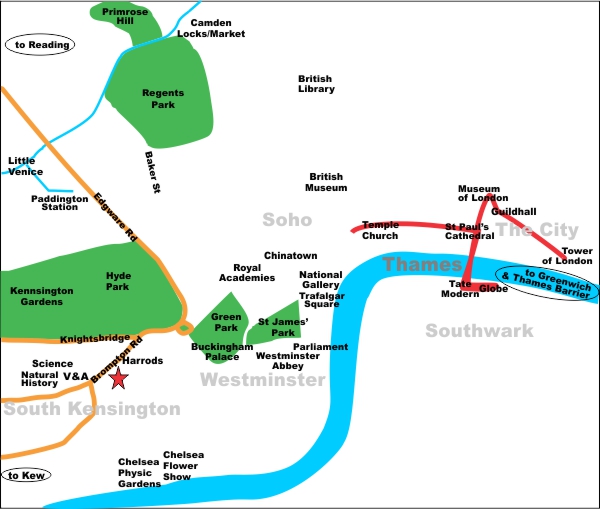 |
| Throughout our stay we always took the bus rather than the more efficient "tube" because we wanted to see things out the windows along the way. The system was well signed. |
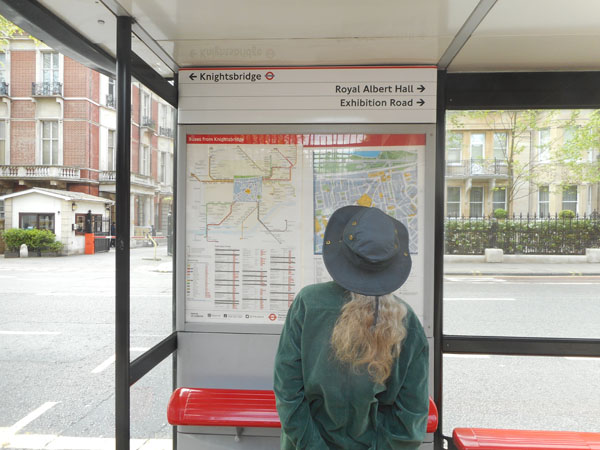 |
...and they tried to keep the buses amused? Well, not really... they usually made sure the riders were informed of service disruptions: Due to an upcoming Marathon, many streets close to Buckingham Palace were going to be closed for a few hours.
(on another day a bus we were on made an announcement and then proceeded to take a major diversion to avoid a significant road blockage due to an accident. We don't know what happened to the folks waiting at the bus stops we never passed) |
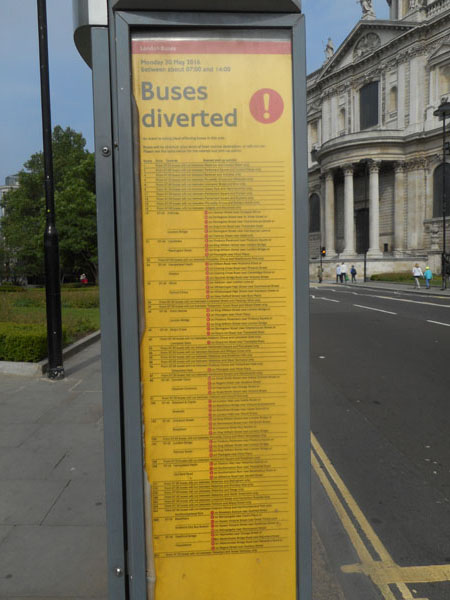 |
We were so glad to have somone else driving and coping with traffic: bicycles and motorcycles were constantly riding up between lanes and between vehicles and the curb. |
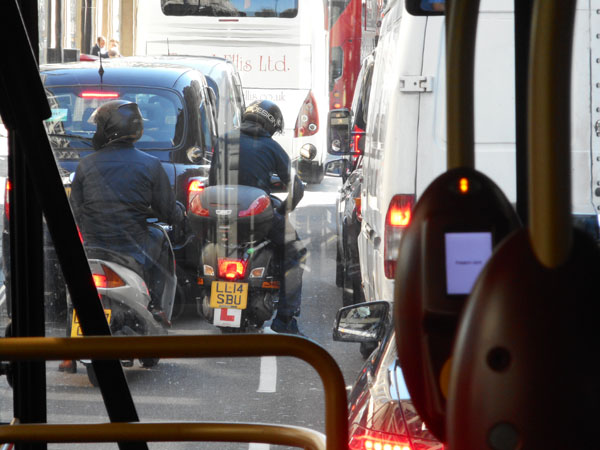 |
So we took bus number 9, which passed Trafalgar Square until it pooped out at Aldwych. There we picked up the number 4, hopping off when it reached Tower Hill.
Once off the bus, we followed many guidebooks' advice and dropped into one of the tourist shops to pre-buy our Tower ticket. This avoided a significant line at the Tower's own booth.
We walked past the "Tower Vaults" another collection of tourist trinket shops. |
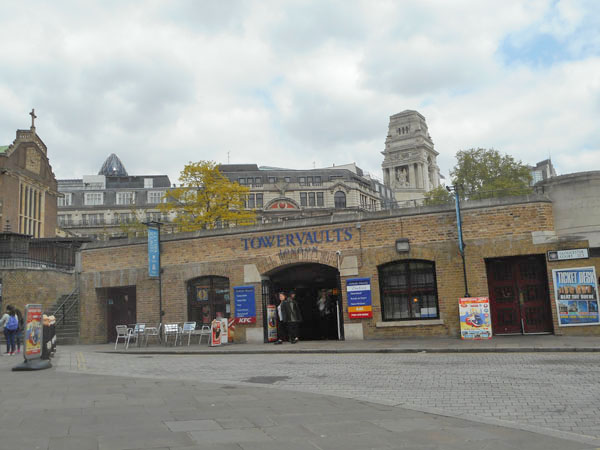 |
| The fortress looks forbidding (the grassed area used to be a water-filled moat) |
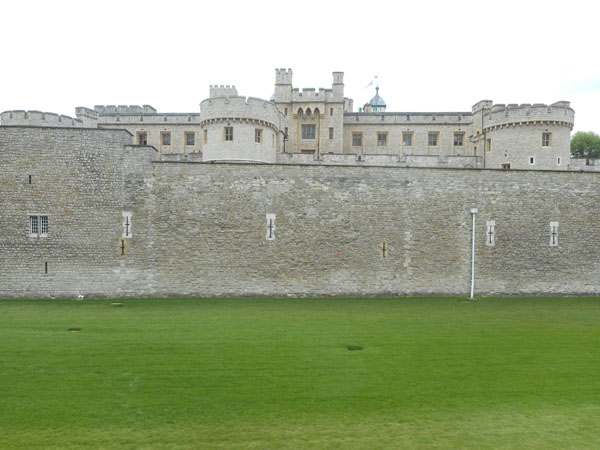 |
But modern London is just around the corner. The tourist entrance is at the white towers at the end of the grass. |
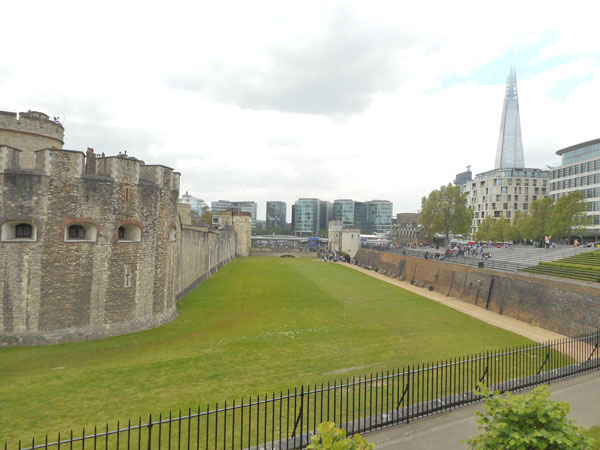 |
| We entered here like many have throughout the ages. |
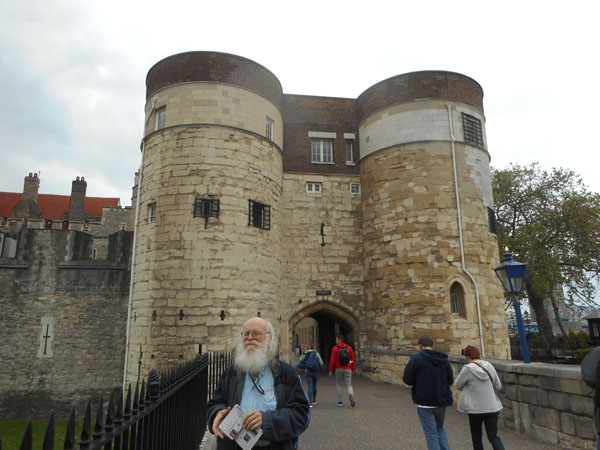 |
| The moat also used to have a few 4-legged guardians. In about 1235 three live lions were given to Henry III by Emperor Frederick II (Henry's shield emblem was three lions). More lions were gifts to sovereigns down the ages. They were kept in cages in the (dry) moat or in the Lion Tower, the remains of which you see in the photo (more about the animal sculptures below). |
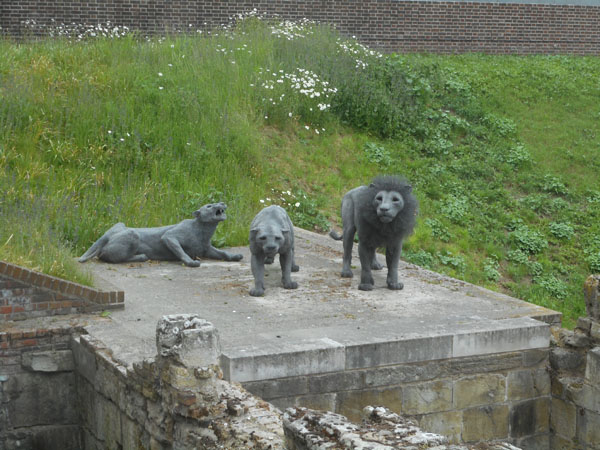 |
There is a model of what it used to look like. The tourist entrance is across the bridge spanning the moat on the left side, and the "Traitor's Gate" entrance from the Thames is on the bottom. |
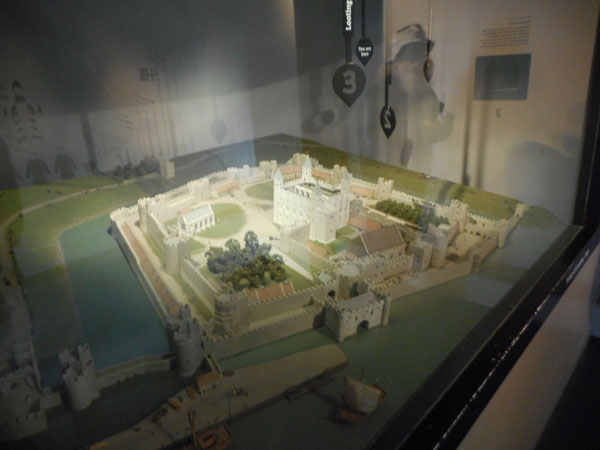 |
| And a map to orient us to what it is now. The most obvious differences are the separation of the Thames from the Traitor's Gate by the construction of the seawall and walking paths, additional barracks against the rear wall, a few gift shops, and far more (and better) toilets. |
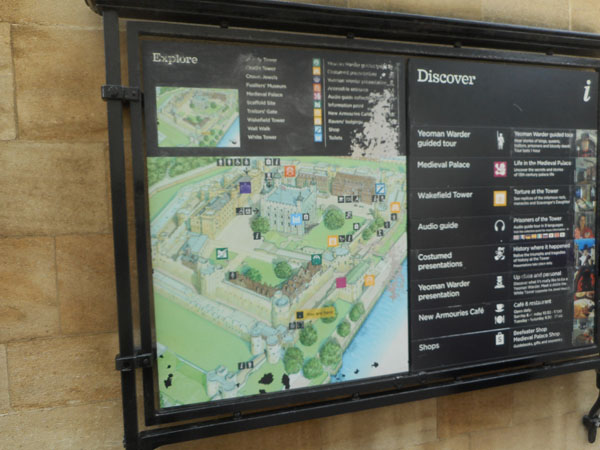 |
The environment feels old |
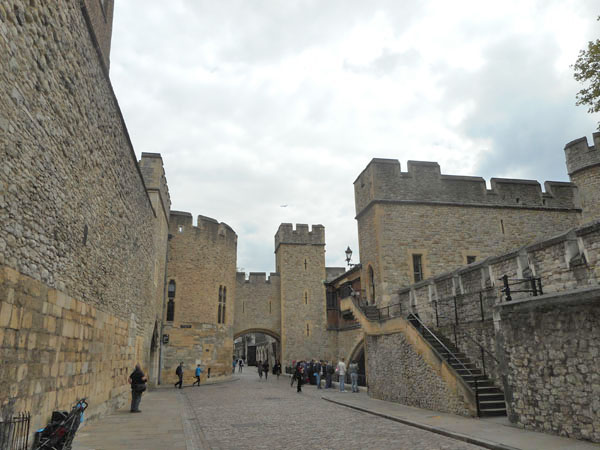 |
| A number of costumed characters help you time travel. |
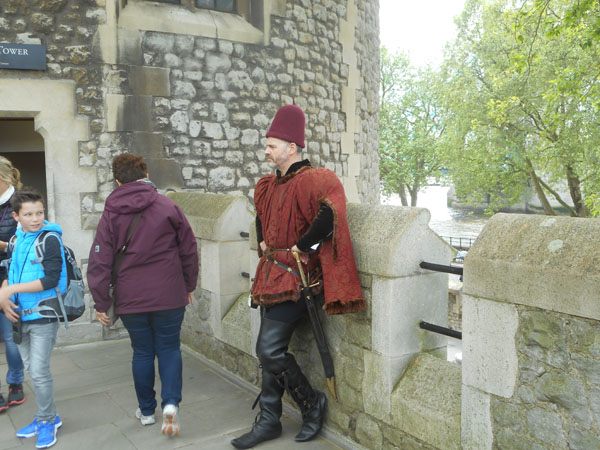 |
| Inside the towers and thick walls are some restored rooms. |
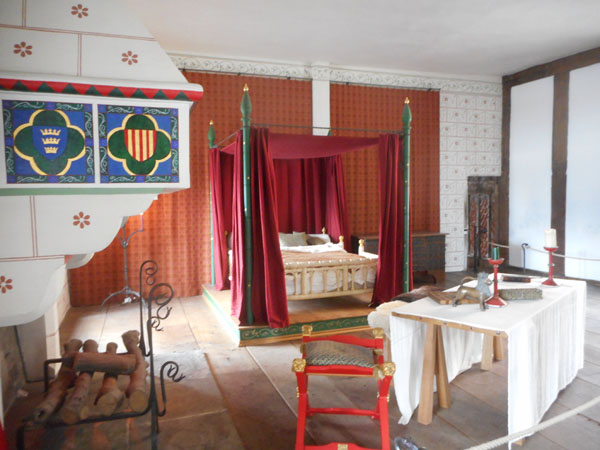 |
| But most are bare. Even those have some great details like this fragmented stained glass. Stained glass windows throughout Britan were smashed during the Protestant reformation. The shards were saved and once the fervor over ostentation died down they were assembled into colorful mosaics that fit the window spaces in churches and other old buildings. Windows were also lost in the bombings of WWII. |
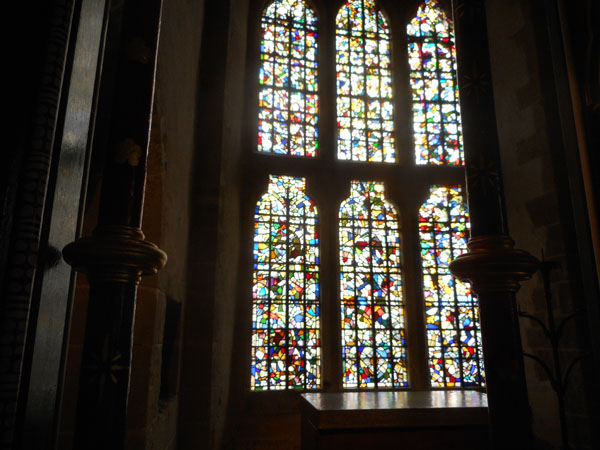 |
| Stalking the battlements let us see the Tower Bridge beyond the far wall. |
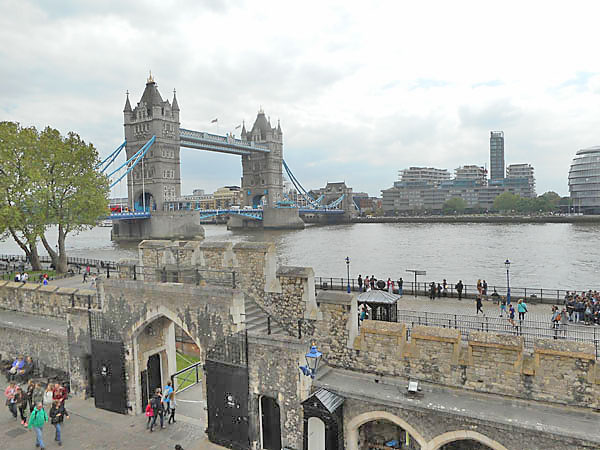 |
| Along the wall were a few metalworked sculptures of guards watching the river... |
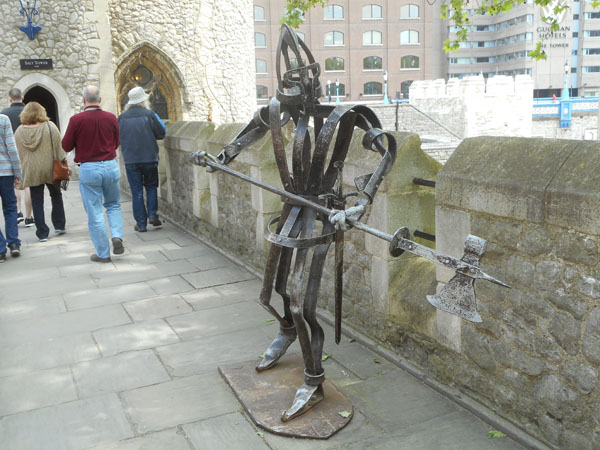 |
| ... and the financial districts. |
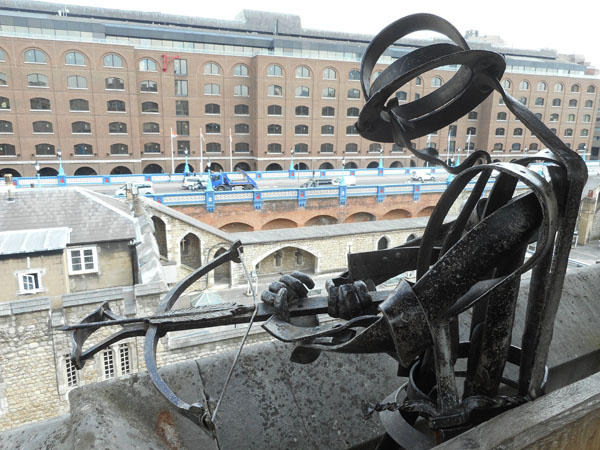 |
| Occasionally one would move and verbally challenge someone on the grounds. |
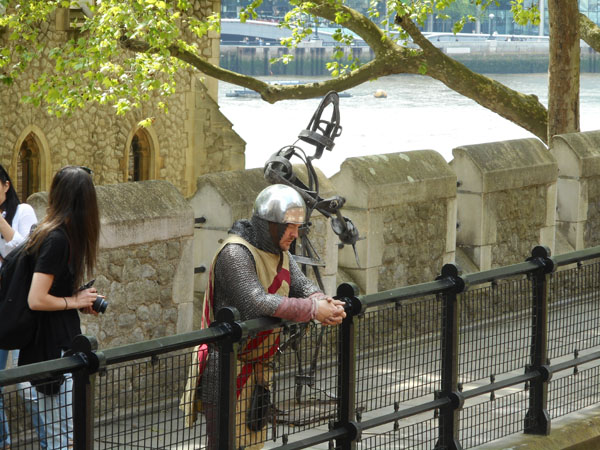 |
| Looking back into the courtyard, we see William the Conqueror's keep, now called the White Tower. Started in 1076, it was a visible expression of Norman power. |
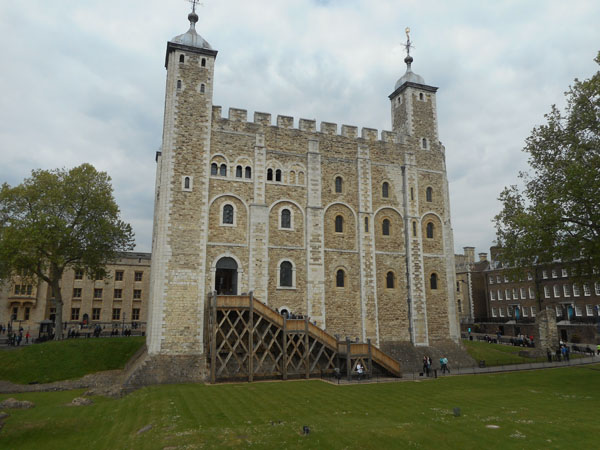 |
| The Tower's grounds also served as the Royal Menagerie. Scattered around were several marvelous animals woven out of chickenwire by Kendra Haste... |
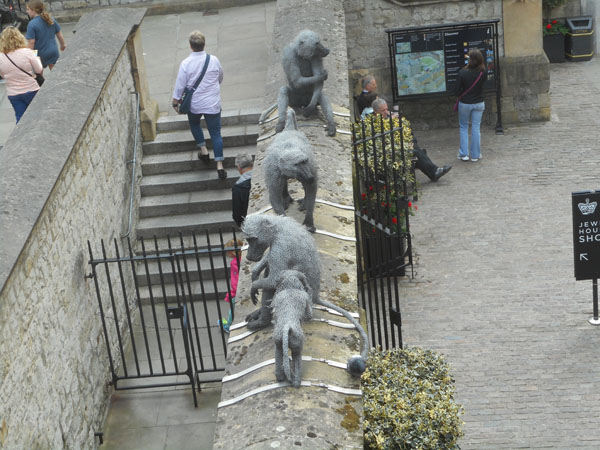 |
There's even a wire polar bear.
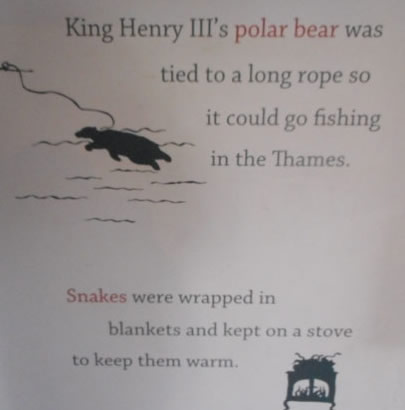 |
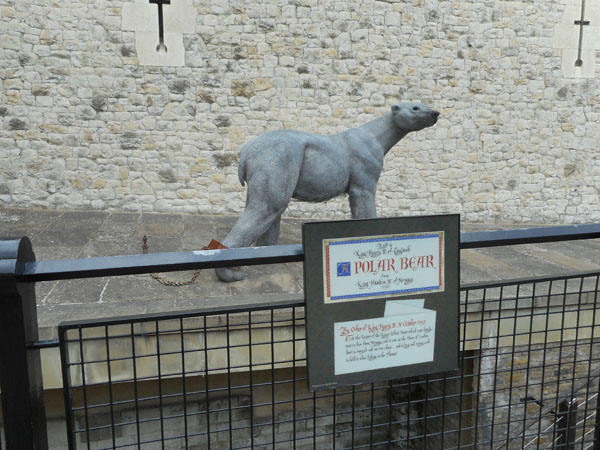 |
| There are still some live animals kept here: the famous ravens of the tower. |
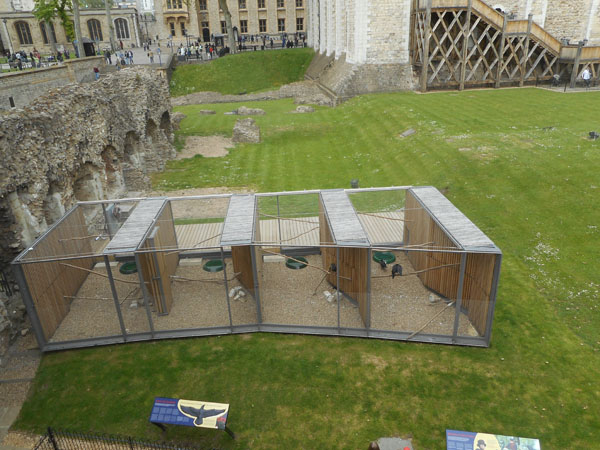 |
| Legend has it that if the ravens leave the tower the kindom will fall. A couple are usually out of their cages and roaming the grounds. |
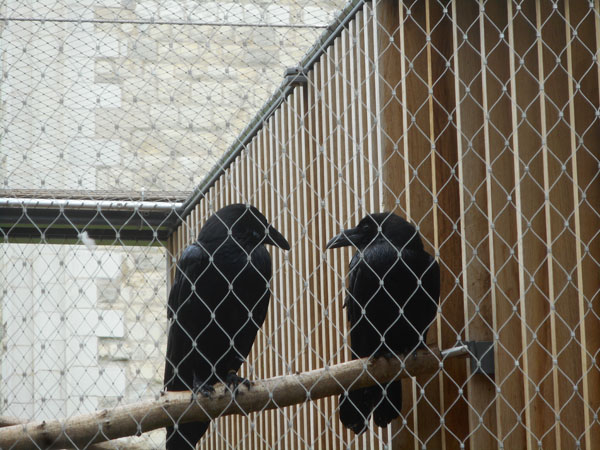 |
| But no one ever said they had to be nice. |
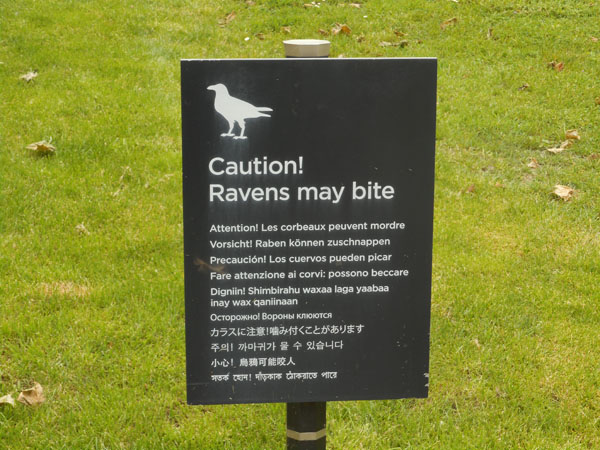 |
| The Yeoman Warders ("Beefeaters") guard the tower and live here. They are generally retired military folk who lead tours and perform general crowd-control duties. |
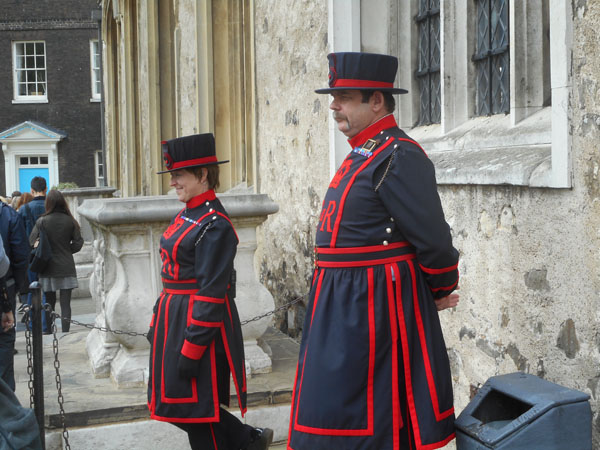 |
| Assisted by a few non-retired folks. The Tower Guard are active service members of the British Army, tasked with guarding the Queen's Jewels. |
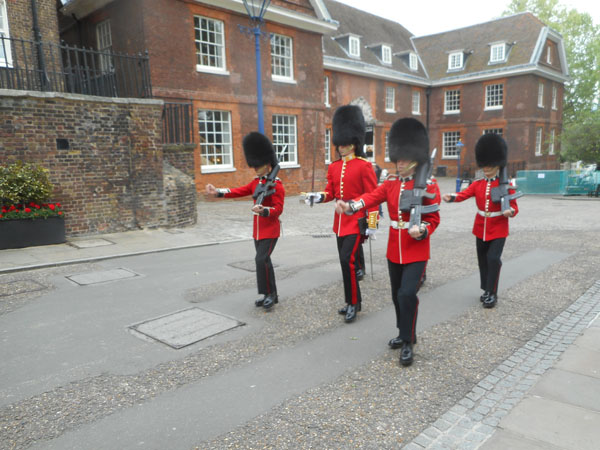 |
History here starts way back ... to Claudius
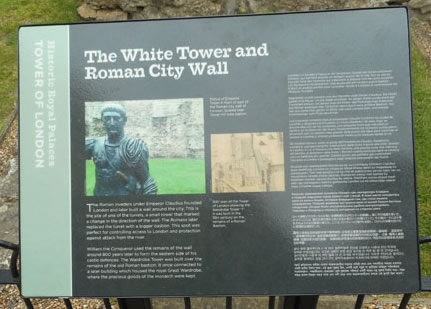
|
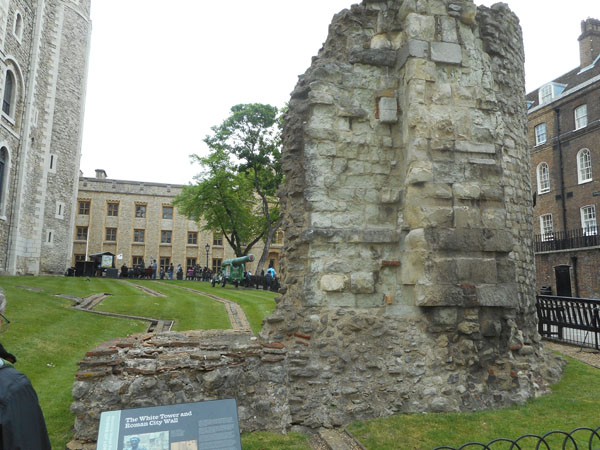 |
| This one's a bit more modern: bronze cast in 1607 by the Flemish, brought to England from Malta circa 1800, and the carriage was locally made in 1827. |
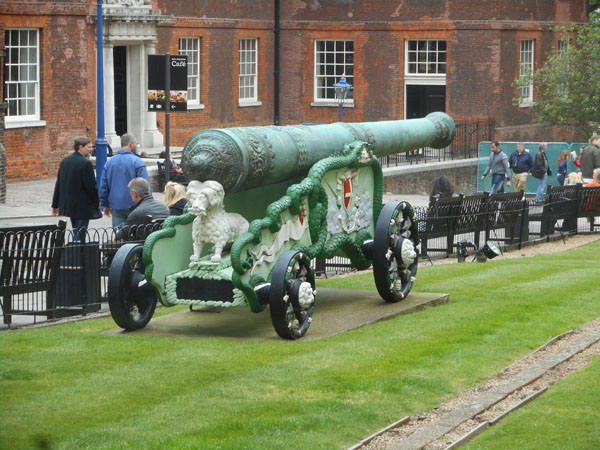 |
| I've heard of folks having "grit" but I didn't know you could keep it in a box. |
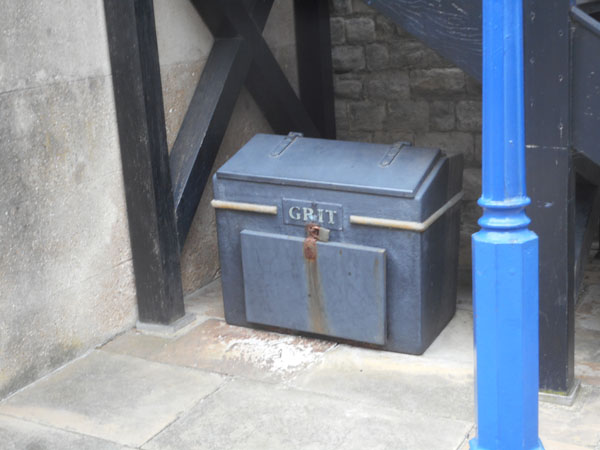 |
The White Tower is organized as a multi-level museum. The armory is interesting ... centuries of styles of, well, armor.
(and, since we're in England, that's an "armoury" containing "armour")
The photos are a bit blurred due to the low lighting and "no flash" requests. |
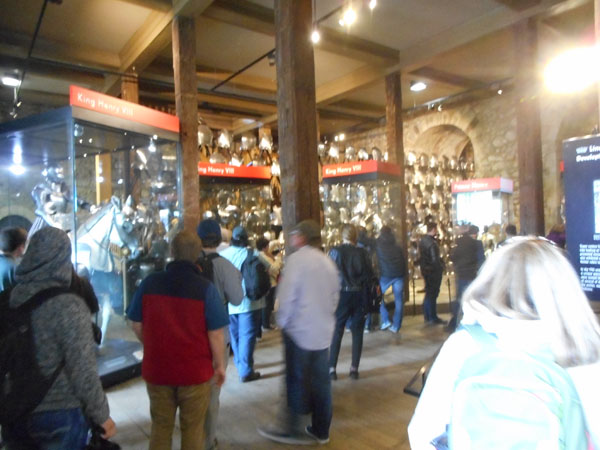 |
| The armor of various kings is on display. |
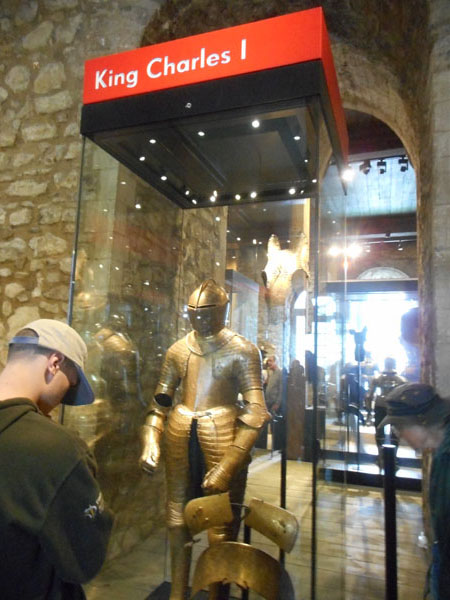 |
| Henry VIII's stood out as significantly larger. |
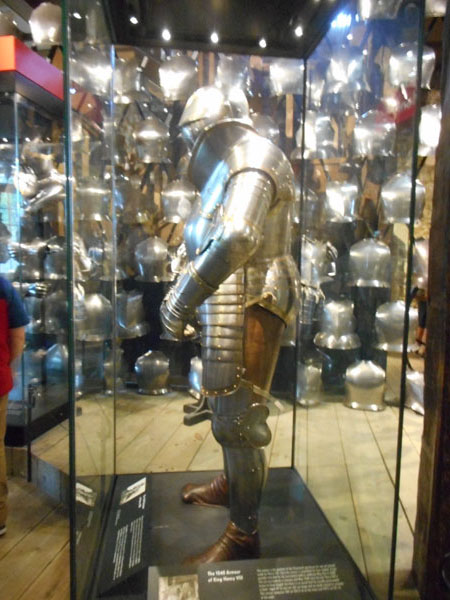 |
| There were also examples of less formal wear ('ware?). |
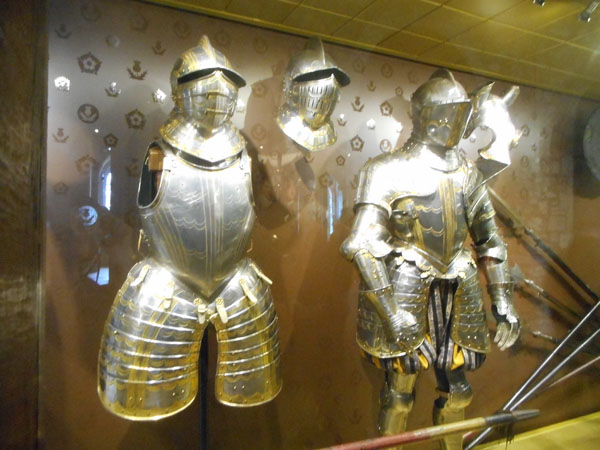 |
| This was the result of a cannon test, not a military campaign |
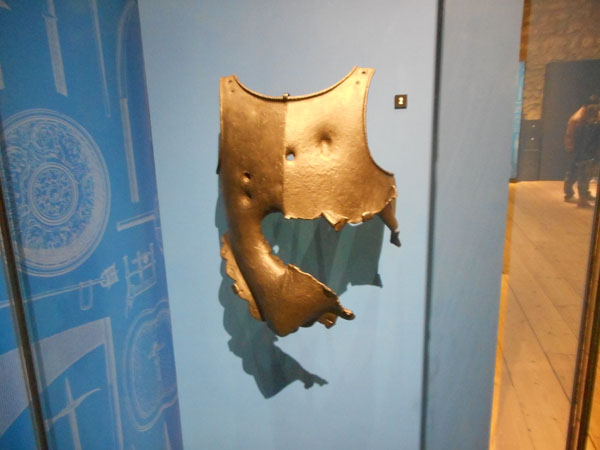 |
Even here we find art (a dragon made of shields, shells and other armory items guarding a treasure in his tummy)
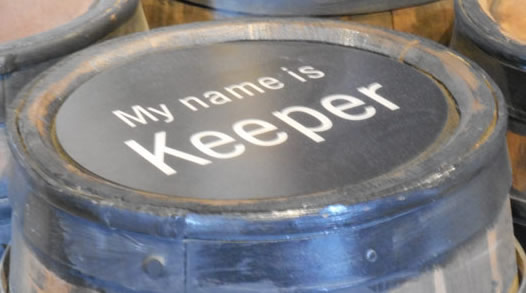
|
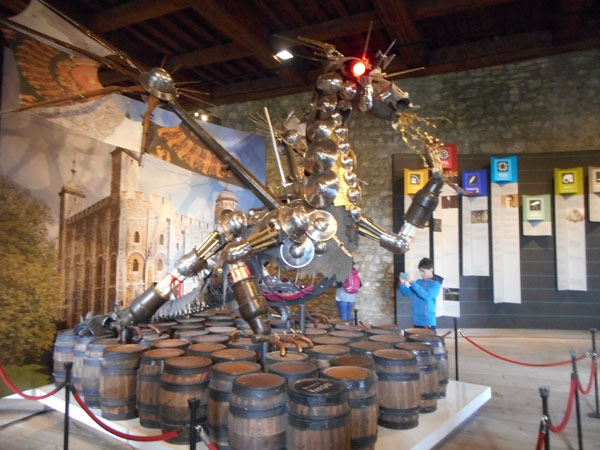 |
| Various cannons were carried off as battle prizes and kept here |
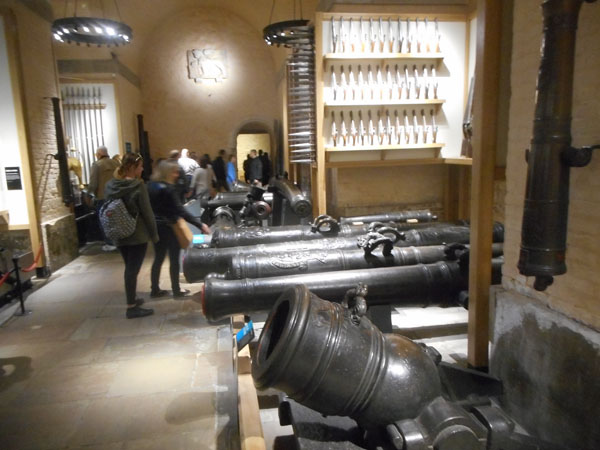 |
| The gift shop had a cute face-detection video screen that placed a crown on your head ... |
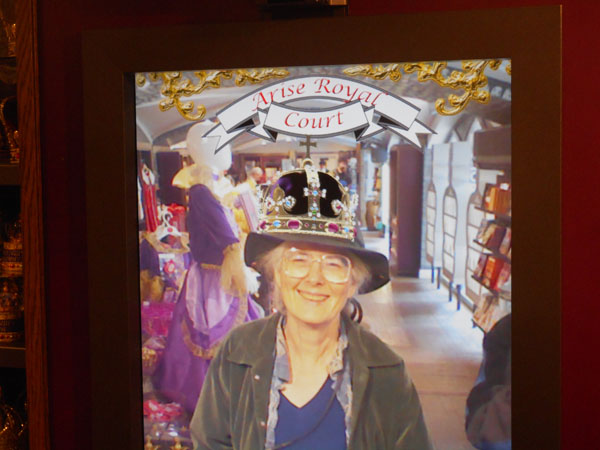 |
| we both had to try it but decided we didn't need the crowns it was pushing. |
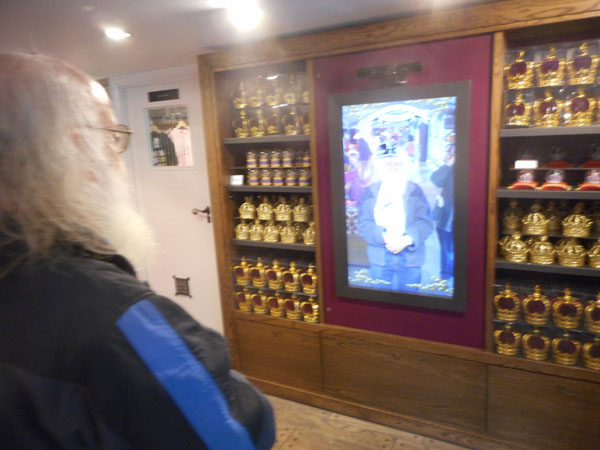 |
| Then out past but not through the "Traitor's Gate" |
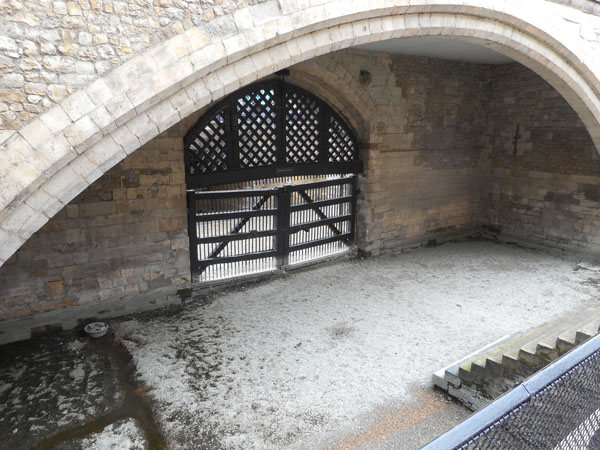 |
| to the waterfront. Back in the Tower's heyday (when the Traitor's Gate was a boat landing), Karen would now be 20 feet offshore and quite wet. |
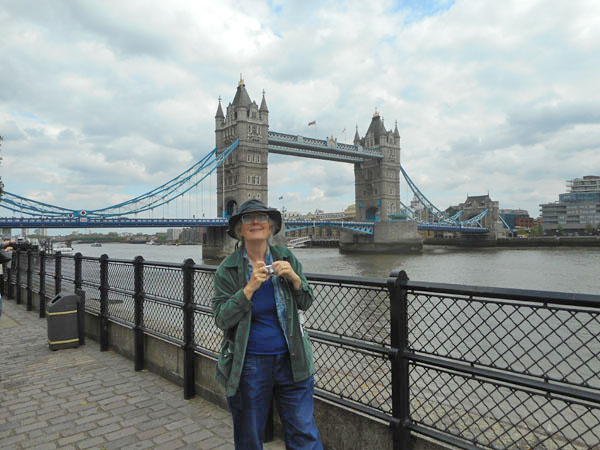 |
| Looking upstream, with the tide out. |
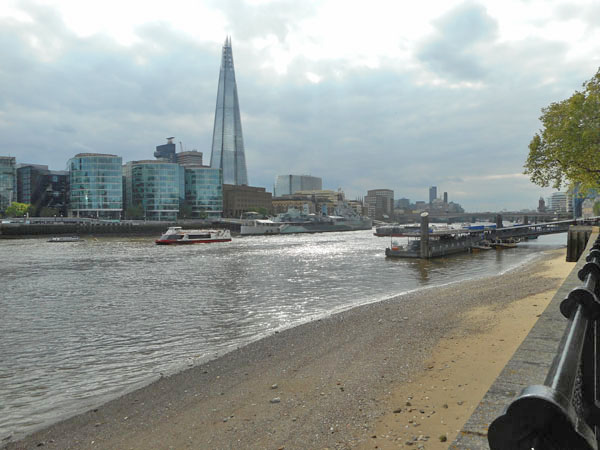 |
| From the Tower we hiked northwest to the Guildhall |
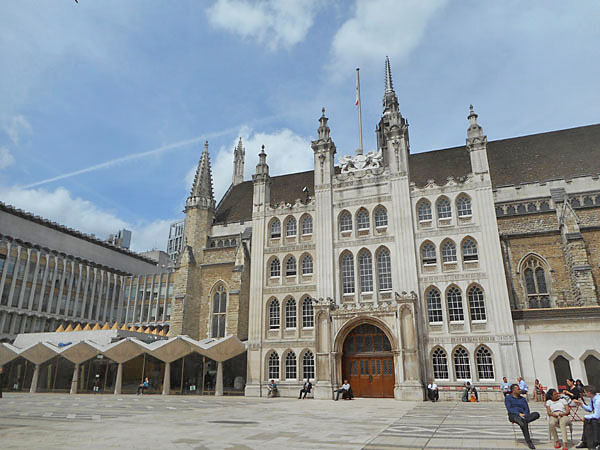 |
| The place for guild meeting and other secular events. |
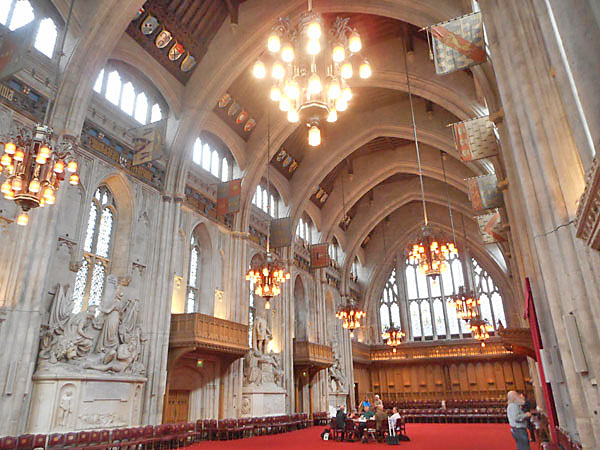 |
| Commerce demanded a Standard Foot and an Imperial Yard. |
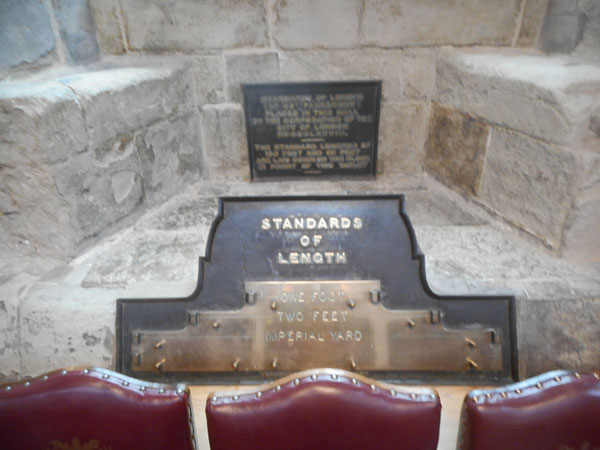 |
| and one of these new-fangled French inventions. This approximate standard meter marks the date that European Union rules demanded the full conversion for retail goods. (But the highways and speed limits are still miles and miles per hour). Who knows what will happen after Brexit? |
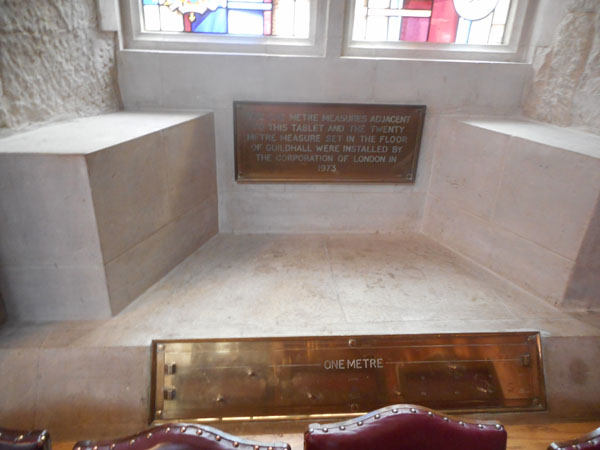 |
When expanding the Guildhall, digging the basement uncovered the foundation of a Roman amphitheatre.
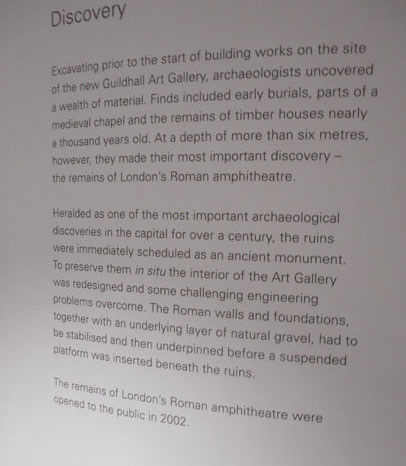
|
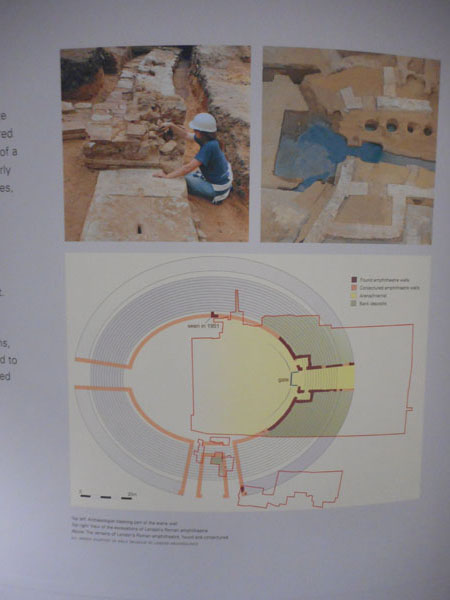 |
| So, suddenly their basement became an historical site... with glass floor, preserved walls, and projected renditions of the amphitheatre's environment and activities. |
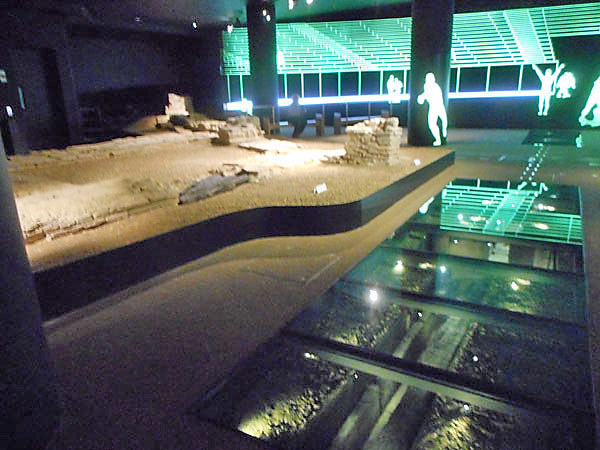 |
| Although only a tiny portion of the site was revealed, its sense of vastness was well conveyed. |
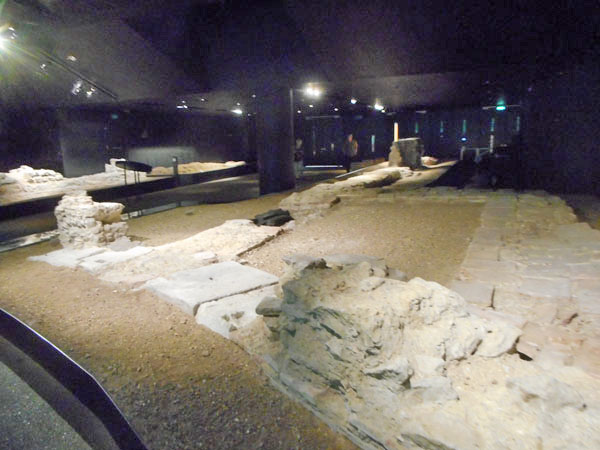 |
| Back up on the surface, we continued our north westward drift to arrive at the Museum of London to see other archeaological finds. |
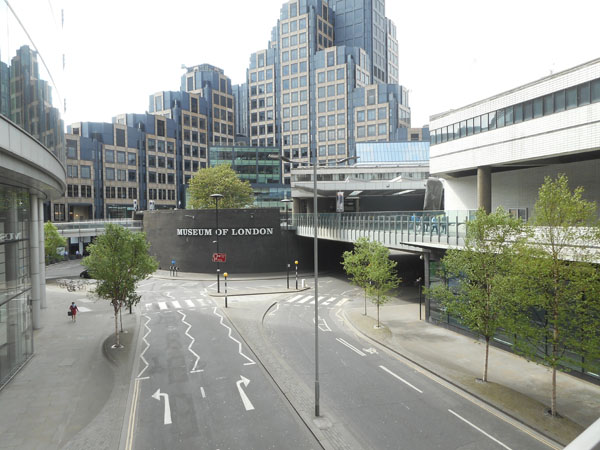 |
| Before entering the museum we see more remains of a Roman Londinium's wall |
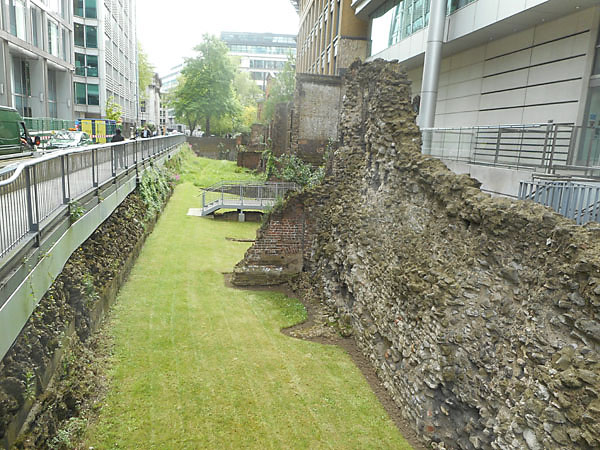 |
| Inside the museum we go much further back in time: this is a graph of the the sea level of past millenia. It varied with the ice ages. When the water was low (locked up in glaciers) people could cross over from Europe on a land-bridge. When the water was high (between ice ages) the UK was again a set of islands. |
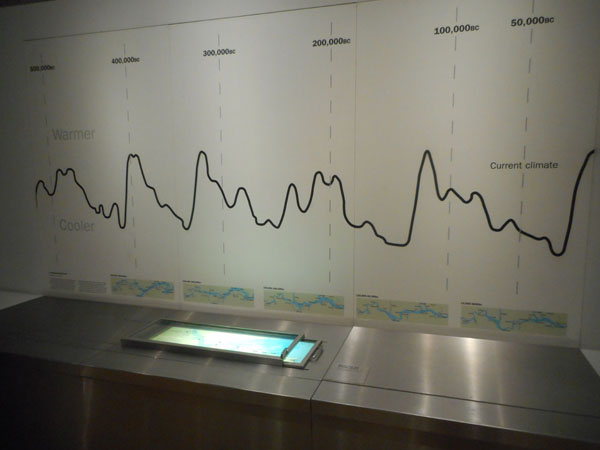 |
| Here's one of the oldest stone axes found in the area |
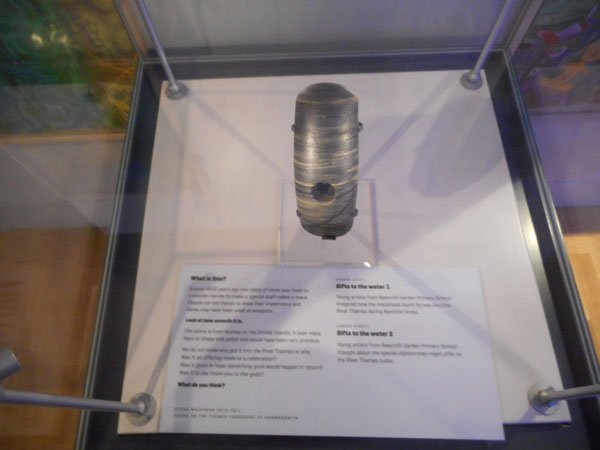 |
| The bulk of the museum was organized as a long time-line walkway. Roman times included glass makers' tools. |
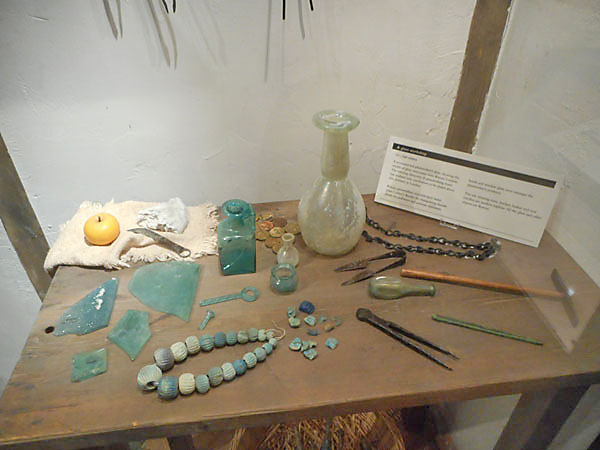 |
| A Roman tile floor of a house and other implements (the chairs are modern re-creations). Our drive-around-the-UK trip had included a stop at an excavated Roman villa. |
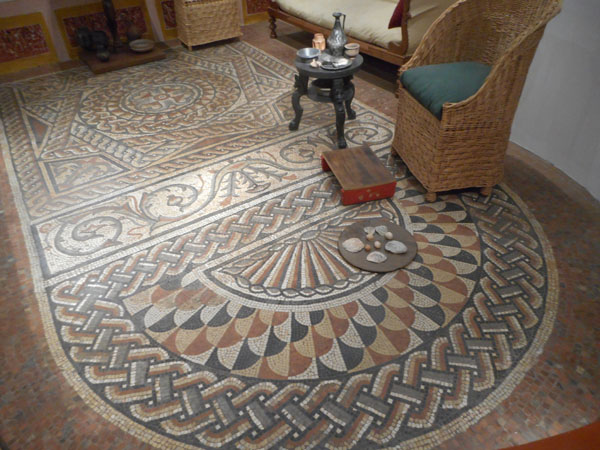 |
| Out the window is another part of the old wall. |
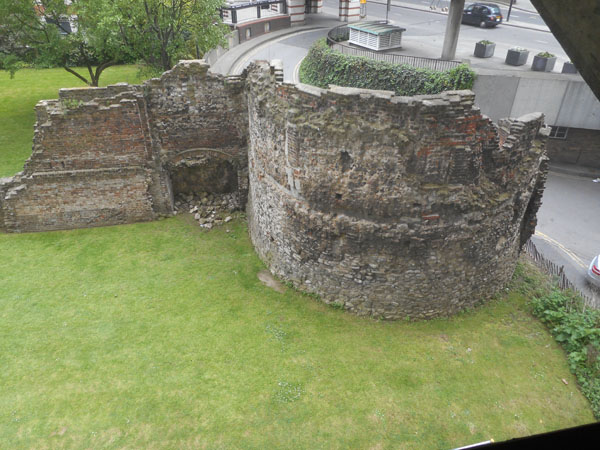 |
| Inside are coins organized by emperor |
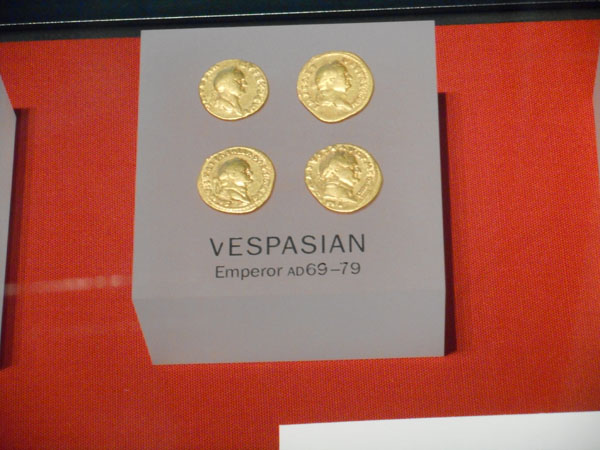 |
And a display of artifacts from a Roman temple
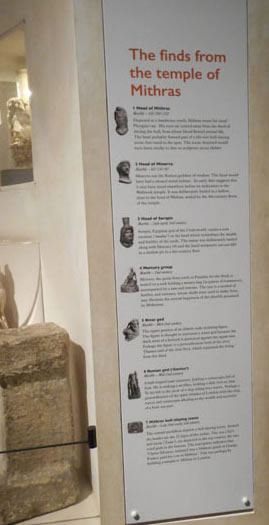
|
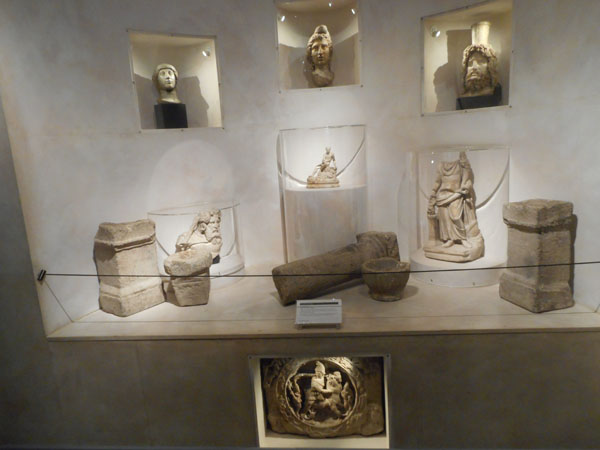 |
| There were then displays taking you all the way to modern times (including things from the Beatles) |
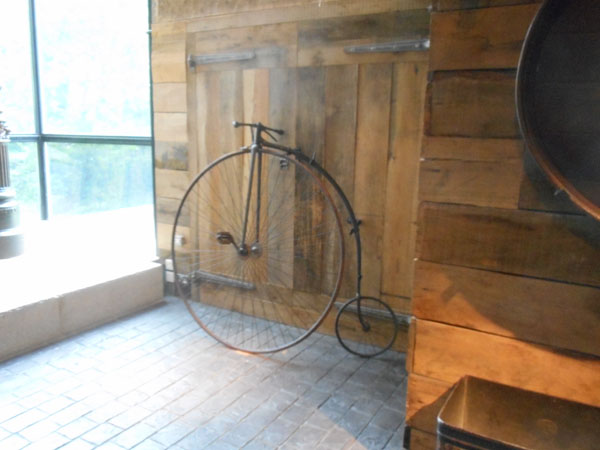 |
| The final item is the Lord Mayor's coach which is still used once a year. |
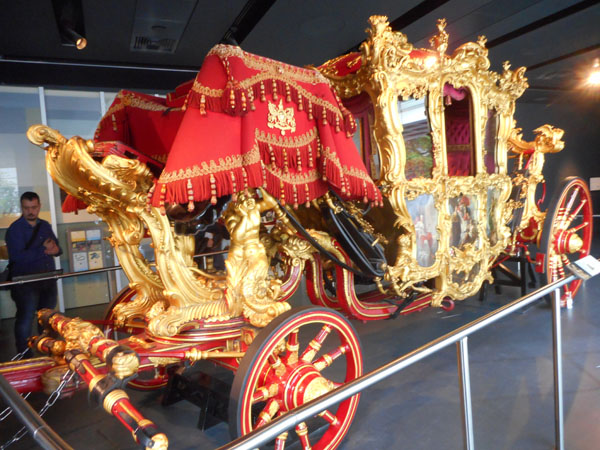 |
| Outdoors again, we cross a pedestrian bridge with these regal-looking dragons as we work our way slightly southwestward... |
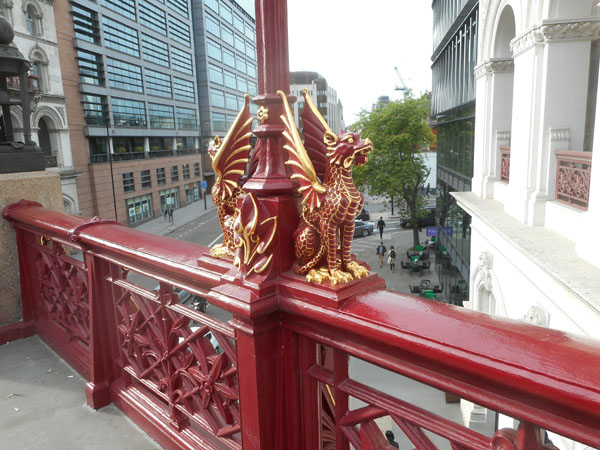 |
| Past the bombed-out Christ Church, its tower still standing and its interior become a garden. |
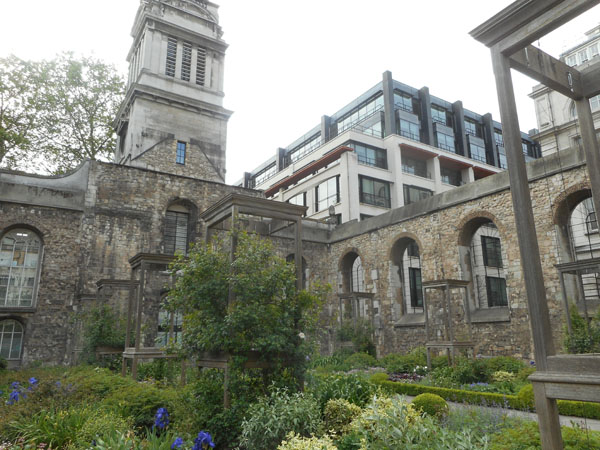 |
| And artistically re-built chimneys... |
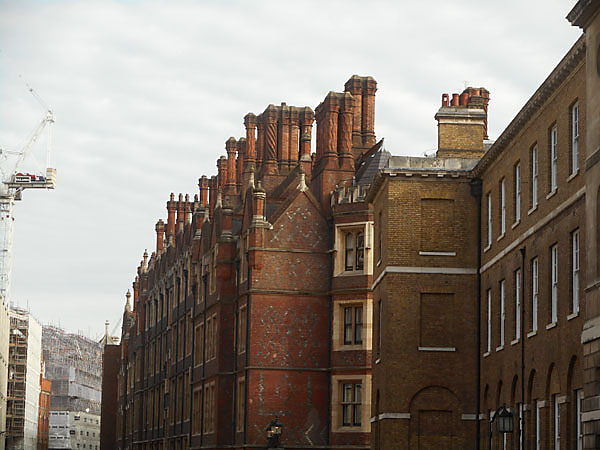 |
| To St Paul's Cathedral |
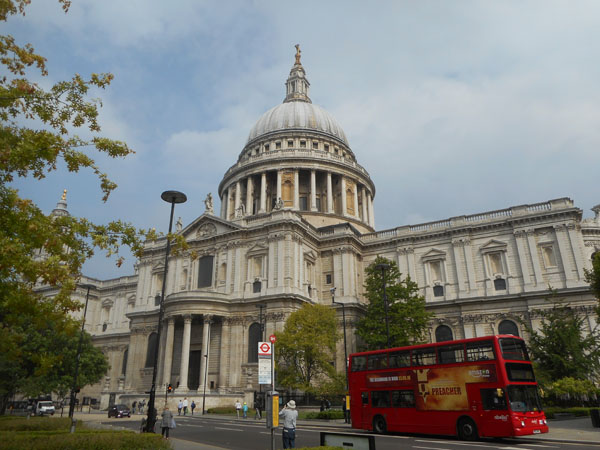 |
| With crowds on its steps |
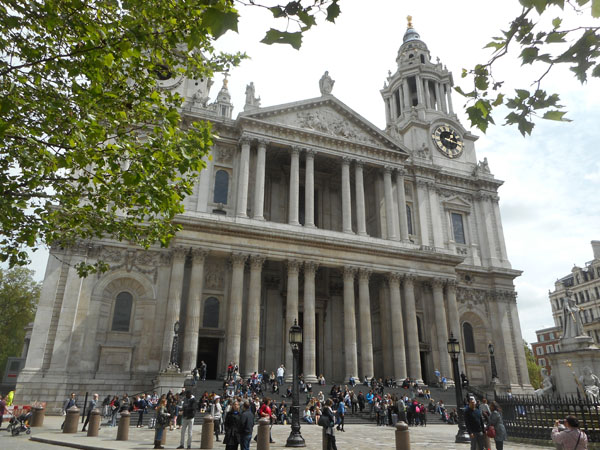 |
| behind it is Paternoster Square |
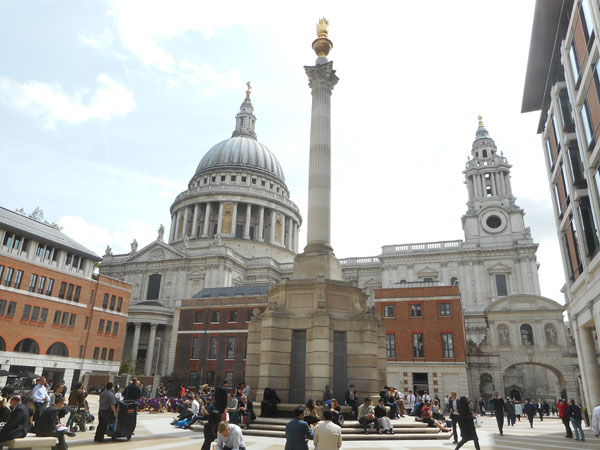 |
This ornate arch is Temple Bar. It was originally built in 1669 on Fleet Street to replace a boundary of the City (we'll get there later). Dickens wrote about it disparagingly in Bleak House in 1853. As an impediment to traffic, it was removed from Fleet Street in 1878. Then it was sold, and served as a private gatehouse out in the country. It changed ownership to a Trust in 1984, but didn't move. Finally the City of London came up with sponsorships and additional funds to bring it back into the City (but not blocking traffic) in 2003.
(every building has a story) |
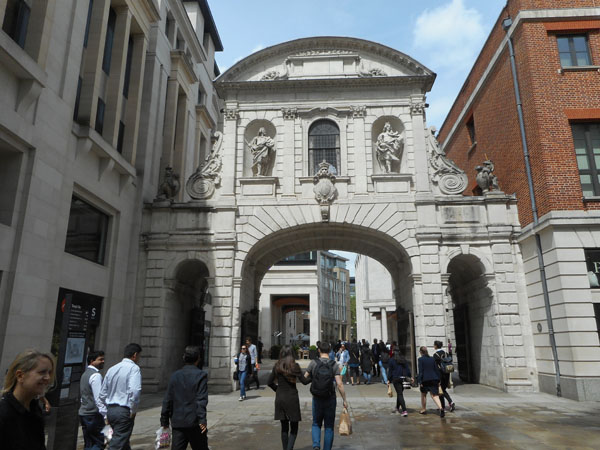 |
| From St Paul's, it's just a short walk south to the Millenium Bridge. |
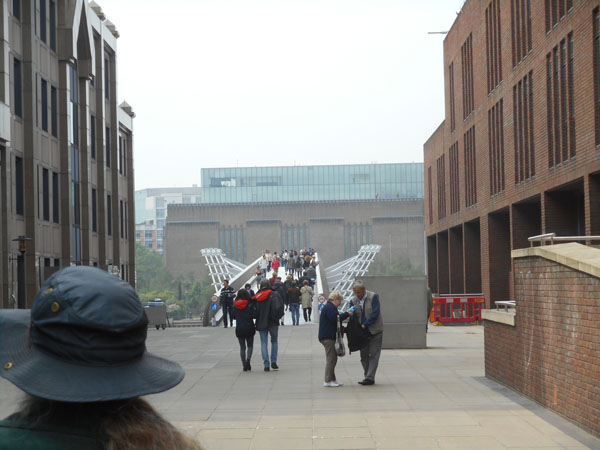 |
| Which offers fine views unobstructed by traffic, both looking up river... |
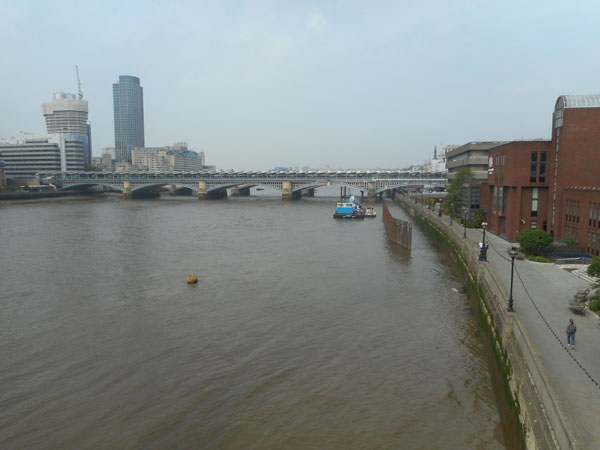 |
| ... and down |
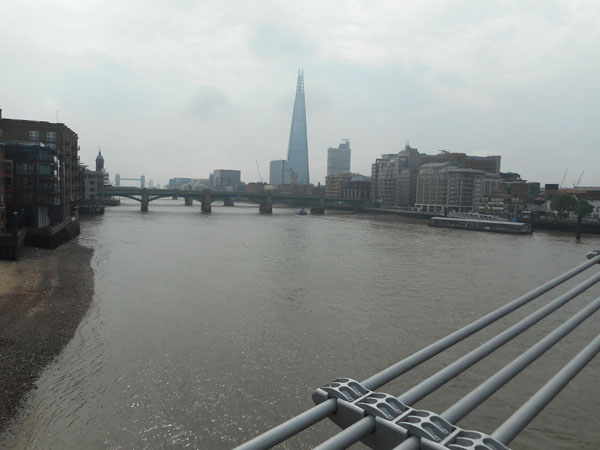 |
| Ahead is our goal: the dull brick ex-powerstation that has become the Tate Modern. |
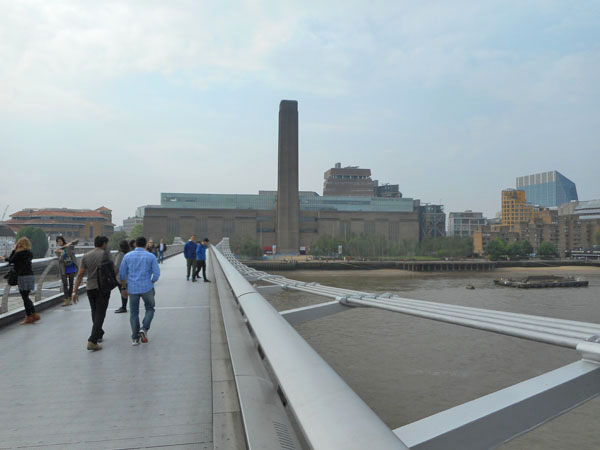 |
| After reaching the southern shore we turn to see St. Pauls, perfectly framed by the bridge. What else would you expect of an art museum entry? |
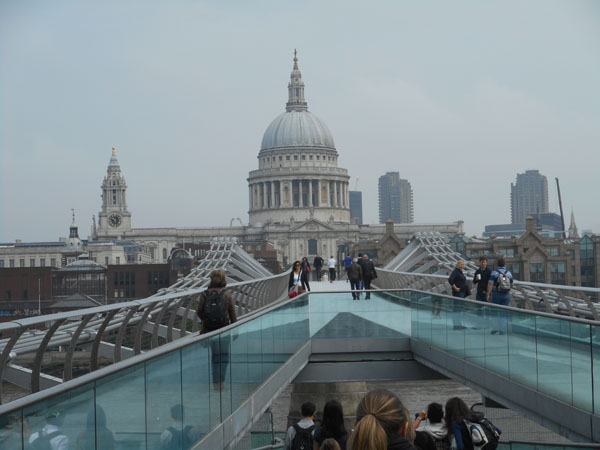 |
| Down on the plaza below, we watch a human Yoda statue get into his outfit... |
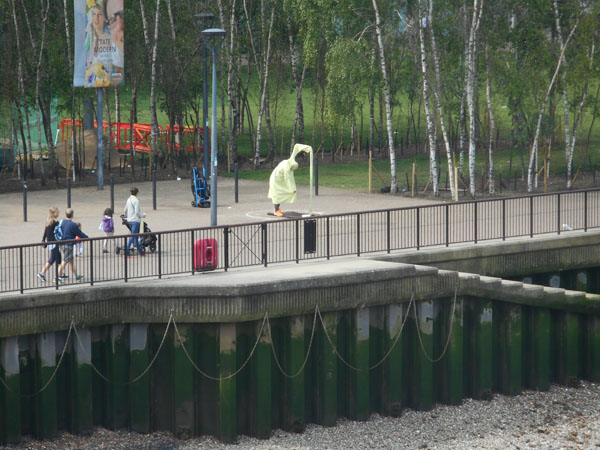 |
...and climb levitate into position |
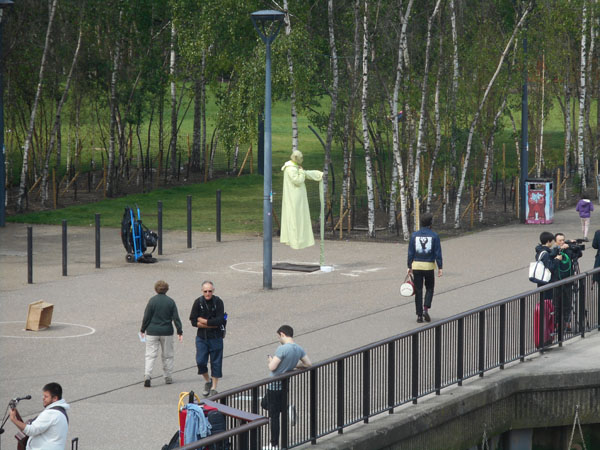 |
Then we enter the Tate Modern art museum.
The new (orange) space will open a month after our visit, so one of the main rooms, the "turbine hall" is closed off. |
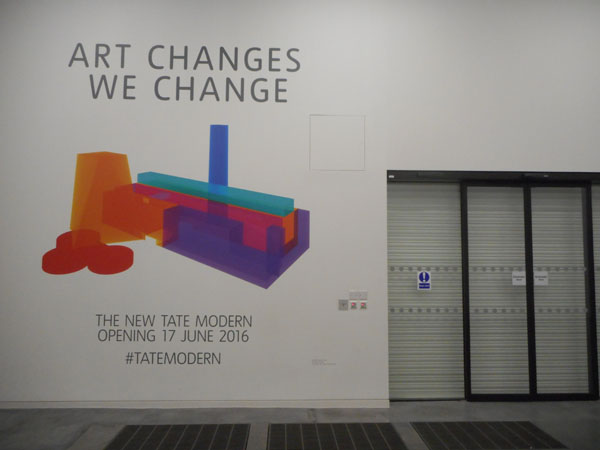 |
The building has stark large rooms. The collection is growing, and the curators rearrange it throughout the space to emphasize different aspects of the pieces. Their signage was quite good at explaining what they were trying to do. This is part of their "Material Worlds" display, showing what artists can see and do with bizarre materials. The tapestry is El Anatsui's Ink Splash II ... made of flattened bottle caps stitched together with copper wire. Disposable objects turned into a shimmering fabric.
If any of these pieces pique your interest, you can browse the entire collection at www.tate.org.uk |
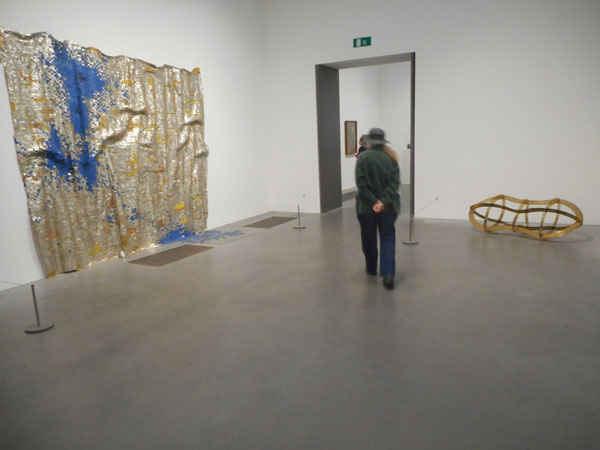 |
Louise Nevelson's An American Tribute to the British People
Giving a feeling like a church's altar, this 12-foot-wide, 9-foot-tall collection of spaces and objects catches our eyes and interest. |
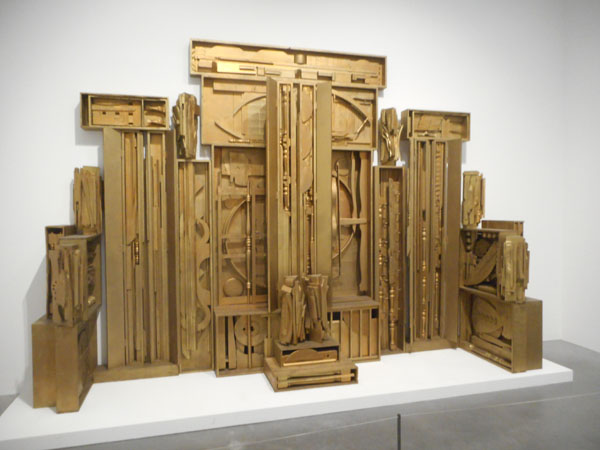 |
Umberto Boccioni's Unique Forms of Continuity in Space
(Designed in 1913, cast in 1972)
A member of the Futurist movement, entranced by aerodynamics and speed. |
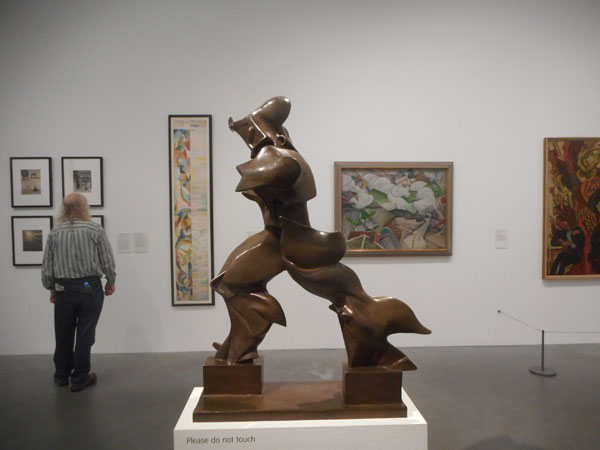 |
A Cildo Meireles exhibit occupied seven rooms.
We were both charmed by his Babel, a towering collection of 800 radios... from tubes to transistors ... all tuned to different stations and playing ... at a barely audible level.
(this also gives a hint of the scale of the rooms themselves) |
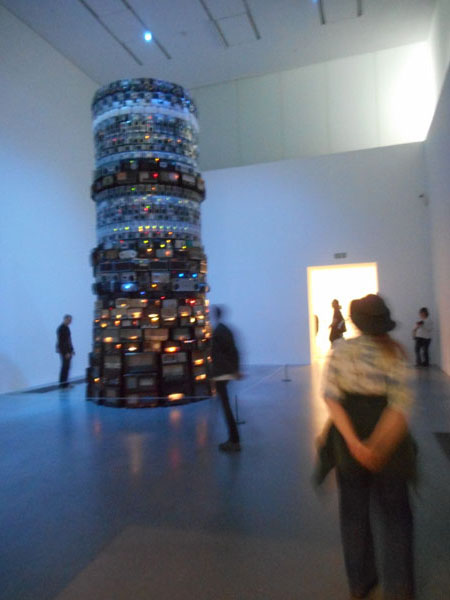 |
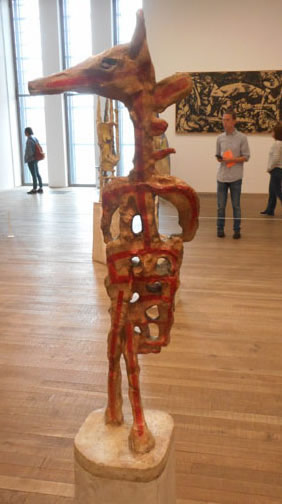 |
Germaine Richier's
Chessboard, Large Version
(plaster, 1959) |
| 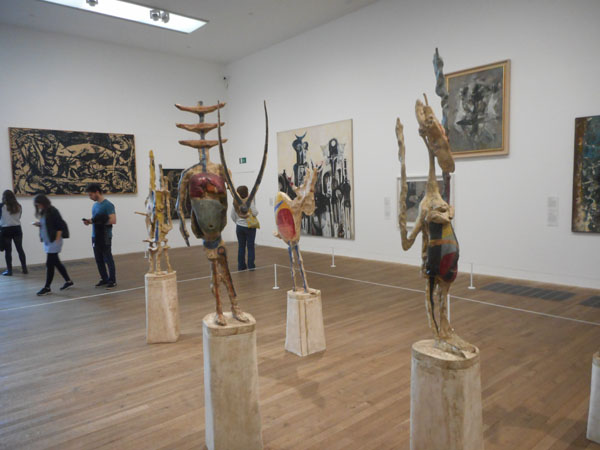 |
Bridget Riley's To a Summer's Day (1980)
The twisting colors were chosen to "create an optical mix in the eye" ... and they do. The piece brought pleasure as we stood or walked by. |
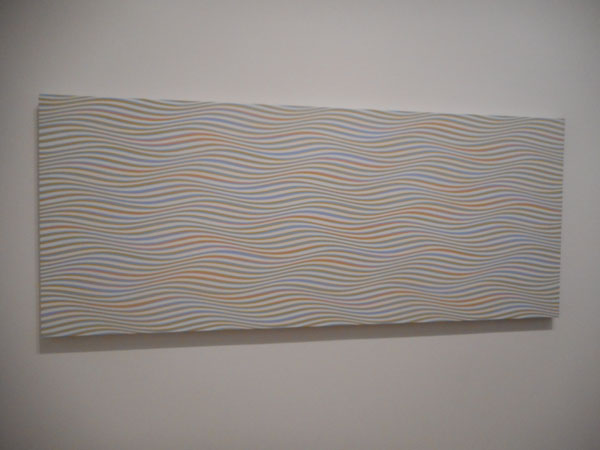 |
When Karen saw this work in person, she finally understood what all the fuss was about. These are both the same piece viewed from different angles. (Carlos Cruz-Diex Physichromie No. 113, 1964).
It's made from thin vertically arranged strips of colored aluminum and raised sections of stainless steel.
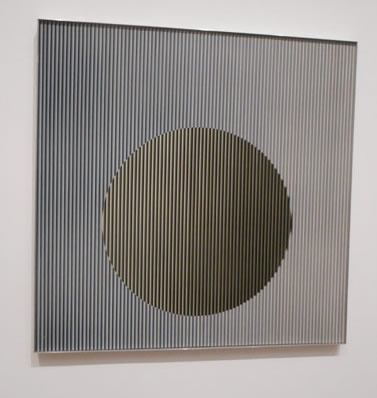
| 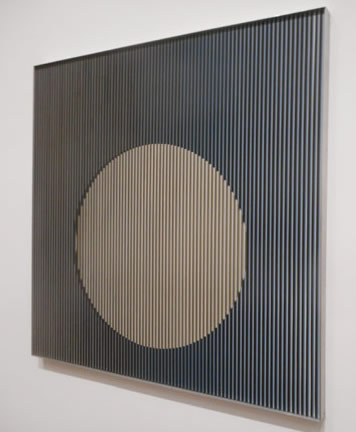 |
As was our habit, we lunched at the museum's restaurant.
Its top floor location let us look back across the bridge. |
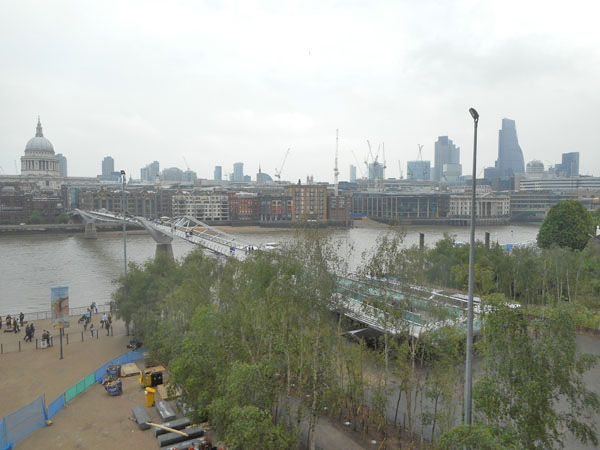 |
After lunch we wandered the south bank a bit: past the re-created Globe Theatre.
People were queuing for the afternoon performance of The Taming of the Shrew. |
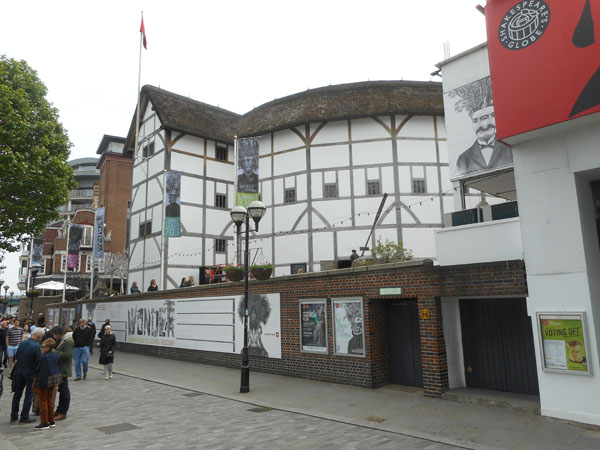 |
| We paused at the booksellers (How Parisian!) |
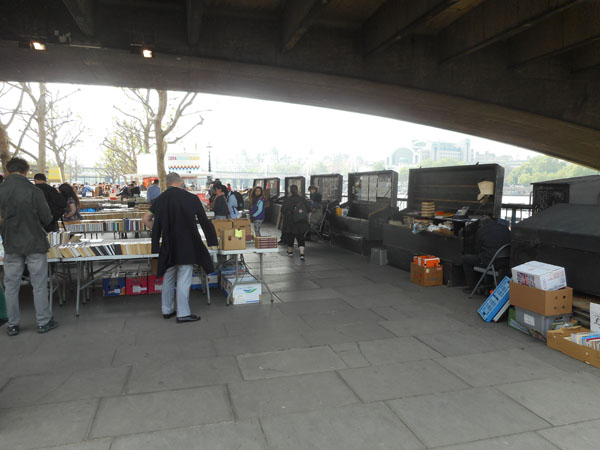 |
| and the "beach": the city's imported sand that the kids (both young and old) are enjoying greatly |
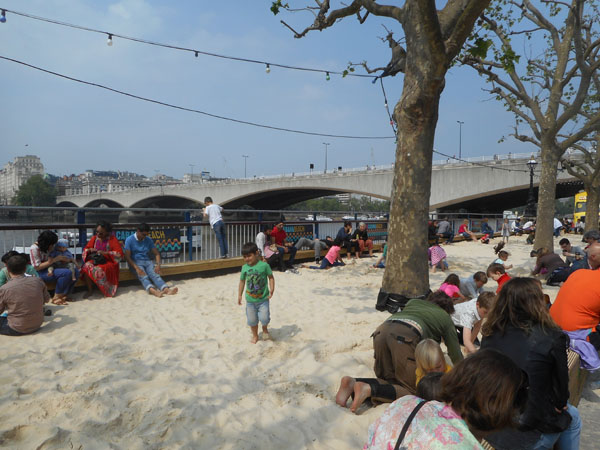 |
| Dick finally has a chance to go "Thames-combing", looking for centuries-old clay pipestems ... and he found a few. |
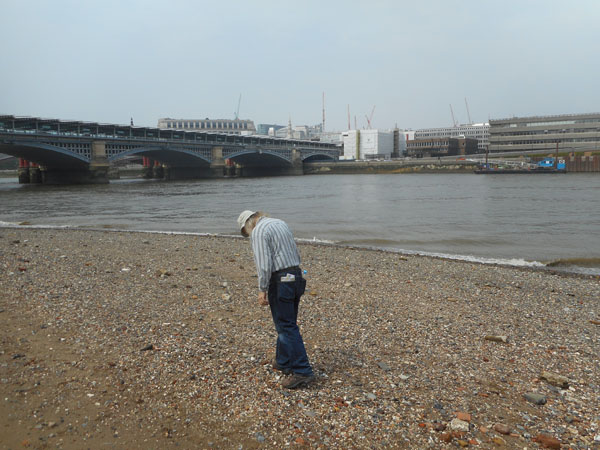 |
We arrived on the south bank by crossing the Millenium Bridge.
We now cross back over the Jubilee Bridge
... which is attached to the rail bridge heading south from Charing Cross station. You may remember the from-the-boat photo of the floating restaurant with one of these supports behind it. |
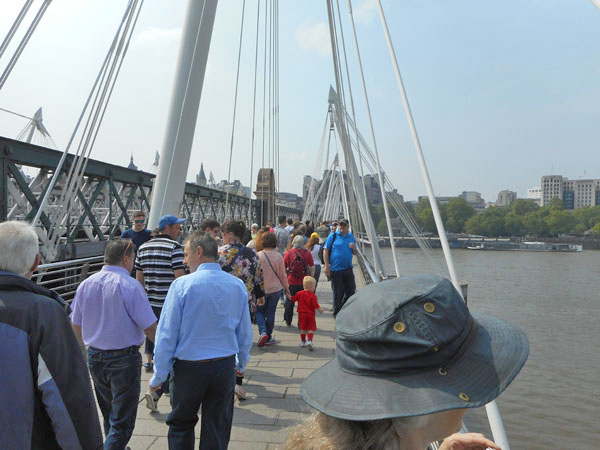 |
Walking the north bank, we pass one of the markers of the boundary between The City and Westminster.
The dragons guard the City. |
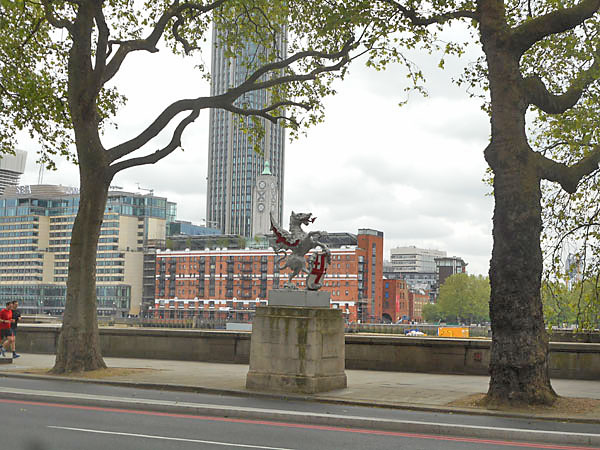 |
| Now we wander east up through the Inner Temple Gardens |
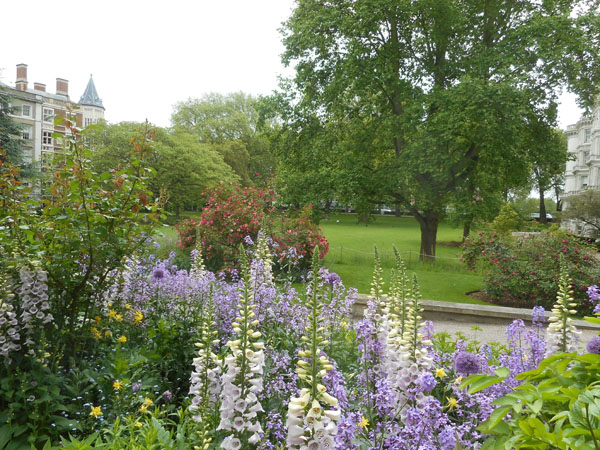 |
| To the plaza of the Temple Church ... the home of the Knights Templar. |
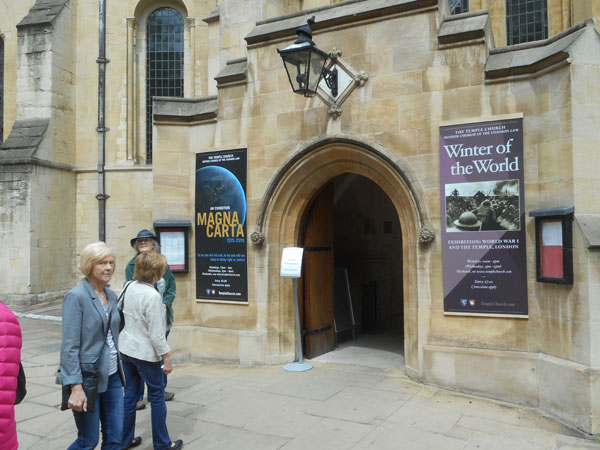 |
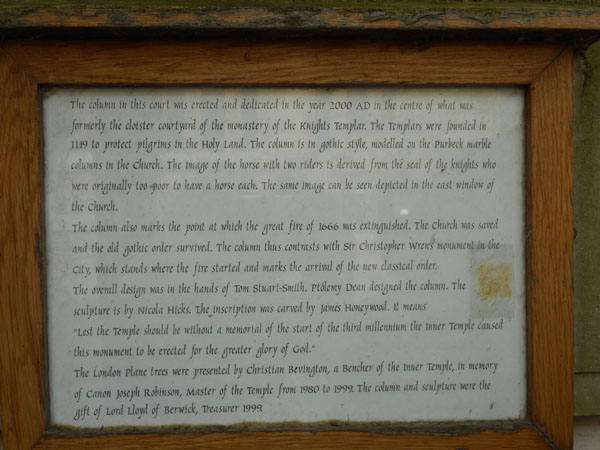 |
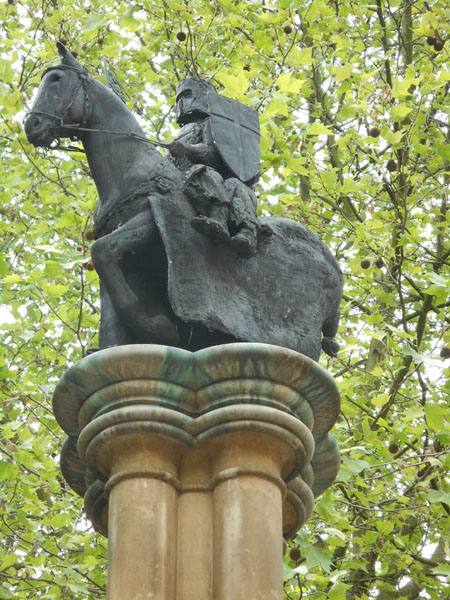 |
A church that fully looks the part of a fortified castle's tower. It was here that King John took shelter during the events that led to the signing of the Magna Carta in the early 1200's. |
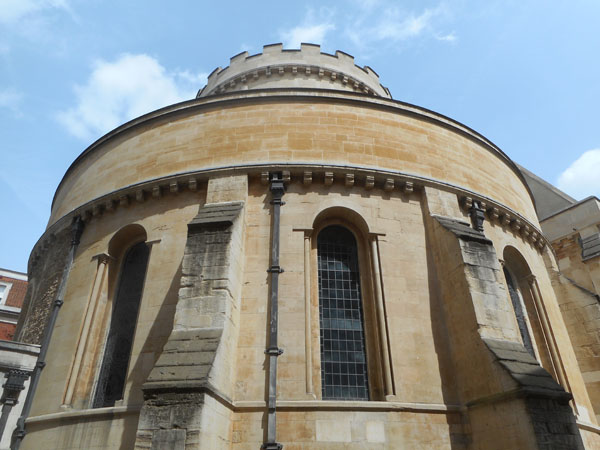 |
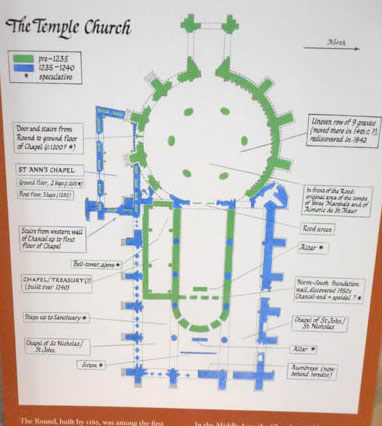 |
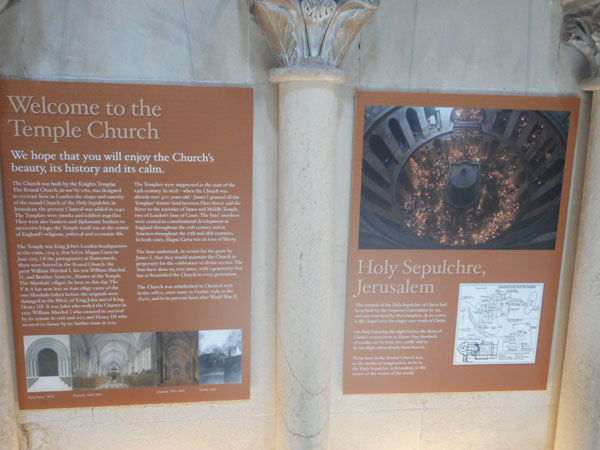 |
Friendly docents at the door and helpful signage gave many glimpses into the history fully steeped into every stone of the church. There was a lengthy series of posters describing the birth of the Magna Carta, the Charter of London, the beginnings of Parliament and the political and religious battles over the centuries.
Members of the church's Middle Temple were among the signatories of the US' Declaration of Independence and Constitution. |
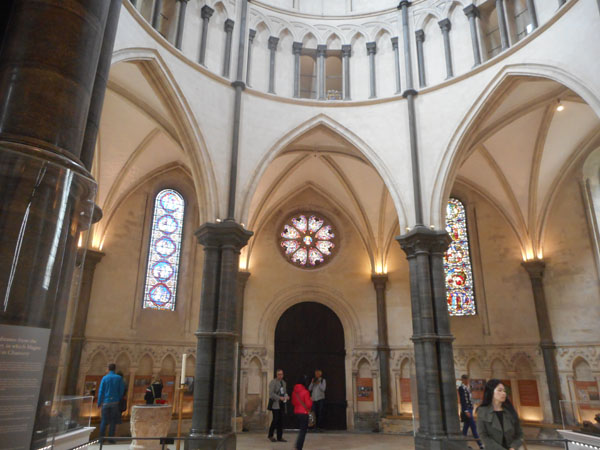 |
| A rose window we could get fairly close to... |
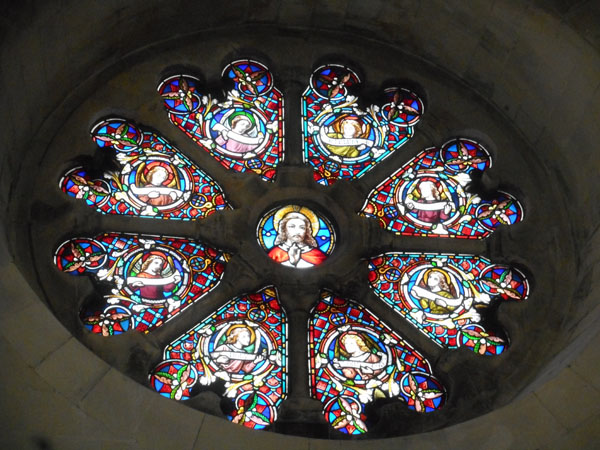 |
| ...and nice glass throughout. |
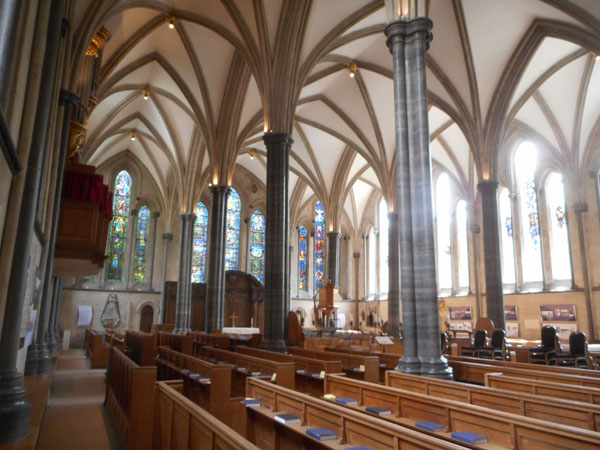 |
| We could ascend the narrow stairs .... |
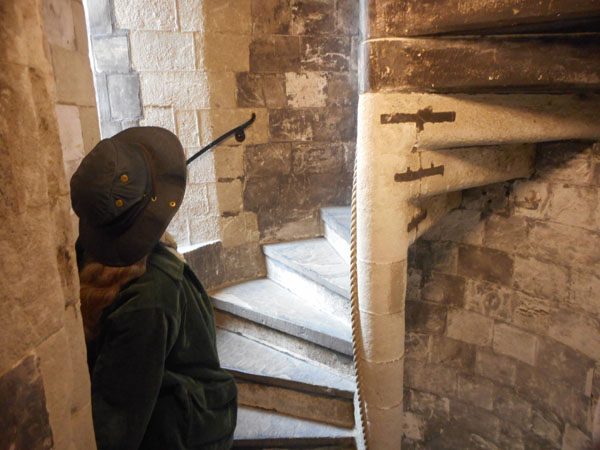 |
| ... to the upper floor in the dome. The church had the usual collection of interred knights, plus a couple of "visiting" interments (under the glass cases) while their home church was being renovated. |
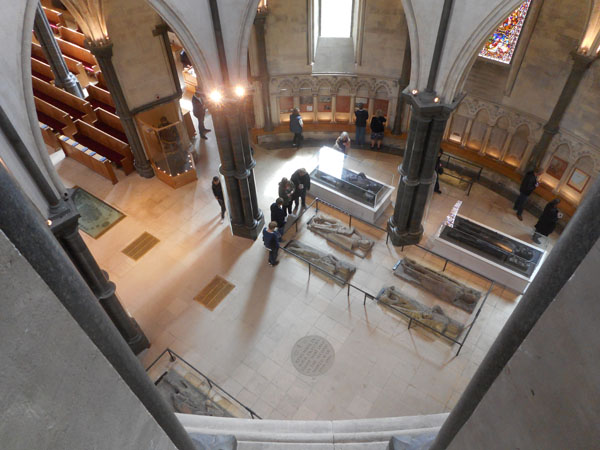 |
A block north of the Temple Church, we find this monument. This is where Strand becomes Fleet Street, which marks the boundary where the road from Westminster enters the old City of London. Remember the Temple Bar back near St Paul's? This is where it originally stood. This is a monument to a monument, featuring the guardian Dragon and Queen Victoria.
By tradition, the reigning monarch pauses here to ask permission to enter The City. The Lord Mayor then presents the monarch with a sword as a sign of loyalty. |
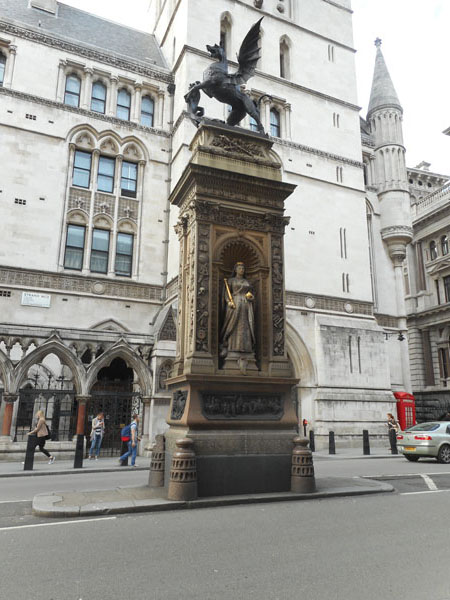 |
| Starting at the monument and continuing quite a ways west are the Royal Courts of Justice. |
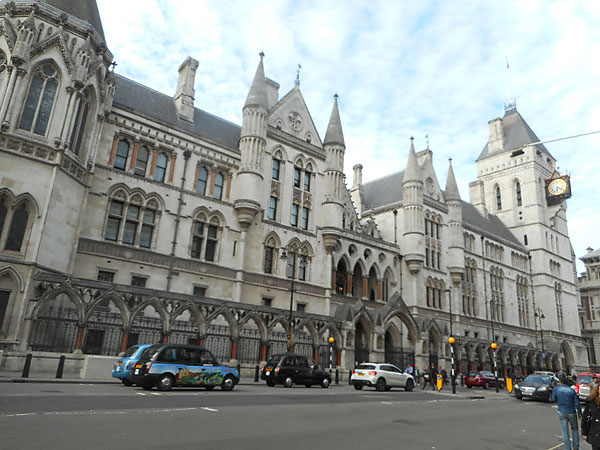 |
These courts are for civil matters: divorces etc.; crimes are tried at "Old Bailey", a few blocks to the east. Like the law, this building is complex: 1000 rooms and 3.5 miles of corridors. |
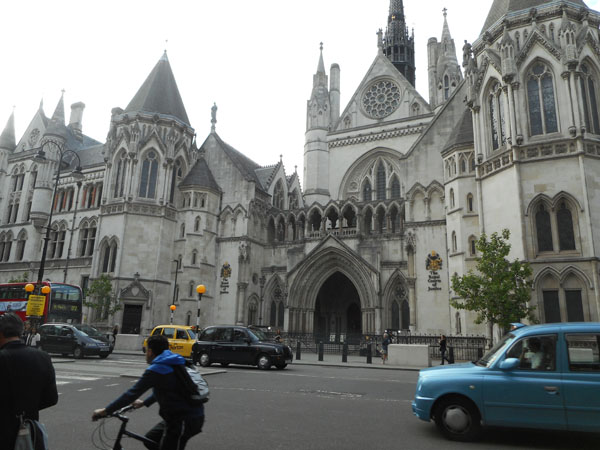 |
We now back-tracked eastward on Strand to catch our #9 bus back home.
Despite the sense of the arrow at the "you are here" mark, traffic flow on Strand is westward (down on this map). But there's a wide spot in the road here... |
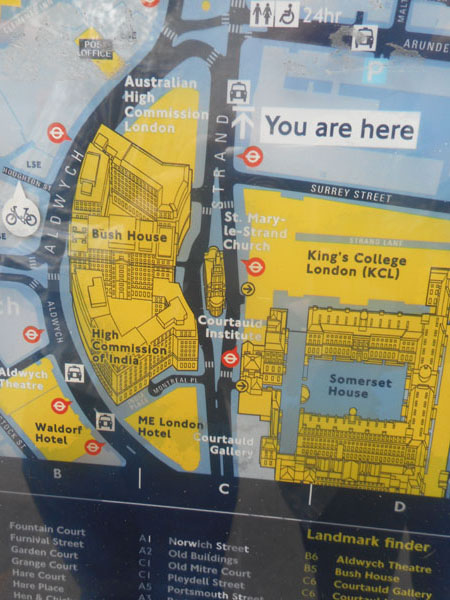 |
So you might as well put (or leave?) a church in it.... Some buildings here do seem stranded in the flow of time (and traffic). |
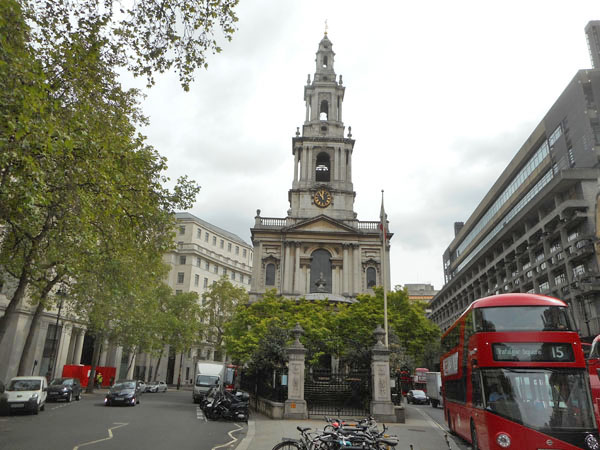 |
| And others are re-purposed: spanning the block to the north is Bush House, the former home of the BBC. We, as long-time listeners, had to at least stop, peek over the construction barricades and wonder what it will become..
Move on with us now to a canal walk ...
|
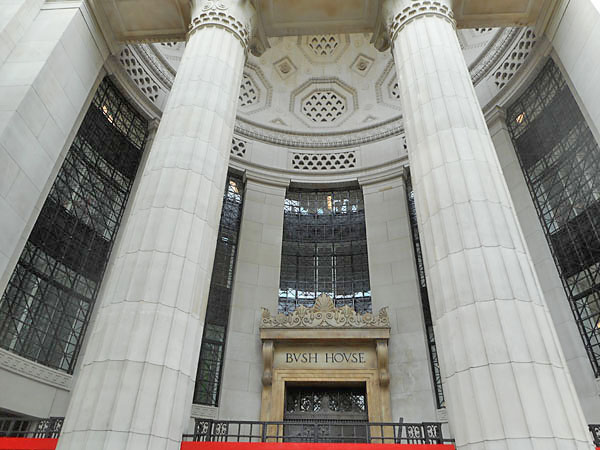 |

















































































































